
March 21, 2025


March 21, 2025

When Dave Flint, the coach of the women’s hockey team, started at Northeastern in 2008, he was told one thing: get a good goalie. As a former collegiate goaltender himself, he took the advice seriously — and it changed the trajectory of his team. Former Northeastern goaltenders Aerin Frankel, Gwyneth Philips and now freshman Lisa Jönsson have become Northeastern legends over an outstanding eightyear run for the program.
“The big thing, especially with goalies, is try to find ways to make
them better but don’t screw them up,” Flint said. “I feel like I’ve done a pretty good job at not screwing up some pretty good goalies.”
Flint saw through the collegiate years of the Boston Fleet’s Frankel and Ottawa Charge’s Philips, who hold three Women’s Hockey Commissioners Association, National Goaltender of the Year awards between them and will both play on Team USA at the 2025 IIHF Women’s World Championships from April 9 to 20.
Northeastern had never won a women’s Hockey East Championship until Frankel’s first year, but the 2018 win started a six-year streak for the team.
enacted by President Donald Trump’s administration, according to emails obtained by The News.
Breghilyn Cheska Bagalso, a second-year biology major on the hunt for her first co-op, applied to the Sabatini Lab at Harvard Medical School, a renowned neurobiology research laboratory.
But after her interview with the lab, Bagalso received an email March 19 stating no one would be hired for the co-op position.
“Over the last couple of weeks, Harvard implemented a hiring freeze due to government funding cuts to biomedical research,” the email, signed by a graduate researcher at the lab and obtained by The Huntington News, reads. “While this co-op position was previously approved and financially supported by our department, the recent restrictions make it unlikely that we will pass a new round of approval in time for the co-op hiring deadlines.” Bagalso’s experience isn’t unique.
Several Northeastern students have reported that co-op interviews and internship offers have been rescinded or altered amid a rapidly-changing hiring landscape due to policies
In the emails, employers — including Harvard University and Cornell University — wrote to applicants that they were uncertain or could not currently accept co-ops due to budget concerns, with some explicitly naming new federal funding policies as the cause. Some employers did not state a reason for hiring changes.
“It is too early to tell how the changing hiring landscape in some industries will impact our students currently applying for co-op positions,” a Northeastern spokesperson wrote in an email to The News March 19. “At the moment, we are not seeing fluctuation in numbers beyond what we would typically see each year.”
A Northeastern assistant cooperative faculty member, or co-op coordinator, who was granted anonymity due to fear they would face repercussions for speaking with The News, said that companies holding off on posting jobs or hiring are likely doing so because of concern over budget allocations for the new fiscal year starting in June.
“A lot of people didn’t realize the impact that they actually had on our program and the success that we had,” Flint said of Frankel and Philips.
When Philips left in 2024, the shoes to fill were giant — but that’s when Jönsson stepped in.
A 20-year-old from Stockholm, Sweden, Jönsson didn’t waste much time causing a stir. She led the NCAA in goals against average, and save percentage in December 2024 and January.
Flint is one of the few head coaches that specialize in goaltending, giving him a unique position to prioritize netminding in recruitment and coaching on the team.
“I think goaltending is a misunderstood position, and then when you have a coach who’s never played goalie or never coached goalies, some of them don’t know how to interact with their goalies — don’t know how to coach them the right way, maybe the right things to say when they’re struggling,” Flint said.
Having a former goaltender as your coach, he thinks, draws potential goaltenders to the program.
“[After pitching something new], we’ll have another discussion of, like, ‘All right, what do you think?’ I want them to be comfortable when they’re in the goal,” Flint said.
What do our neighbors think?
Read about nearby colleges’ opinions about Northeastern.
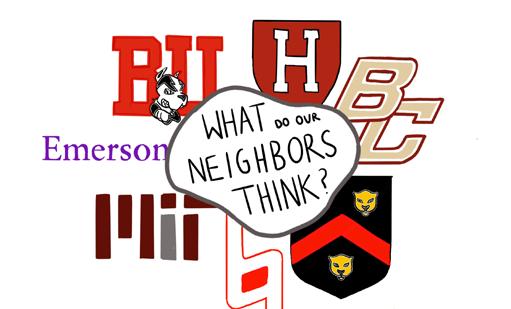
The ‘Slouching Towards’ Series
Read interviews with College Democrats and Republicans.
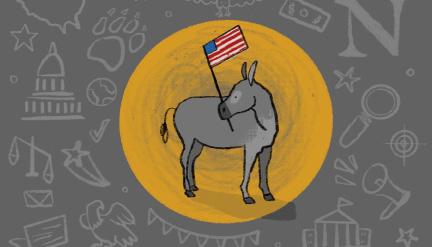
Solve The News’ March crossword!
Answers

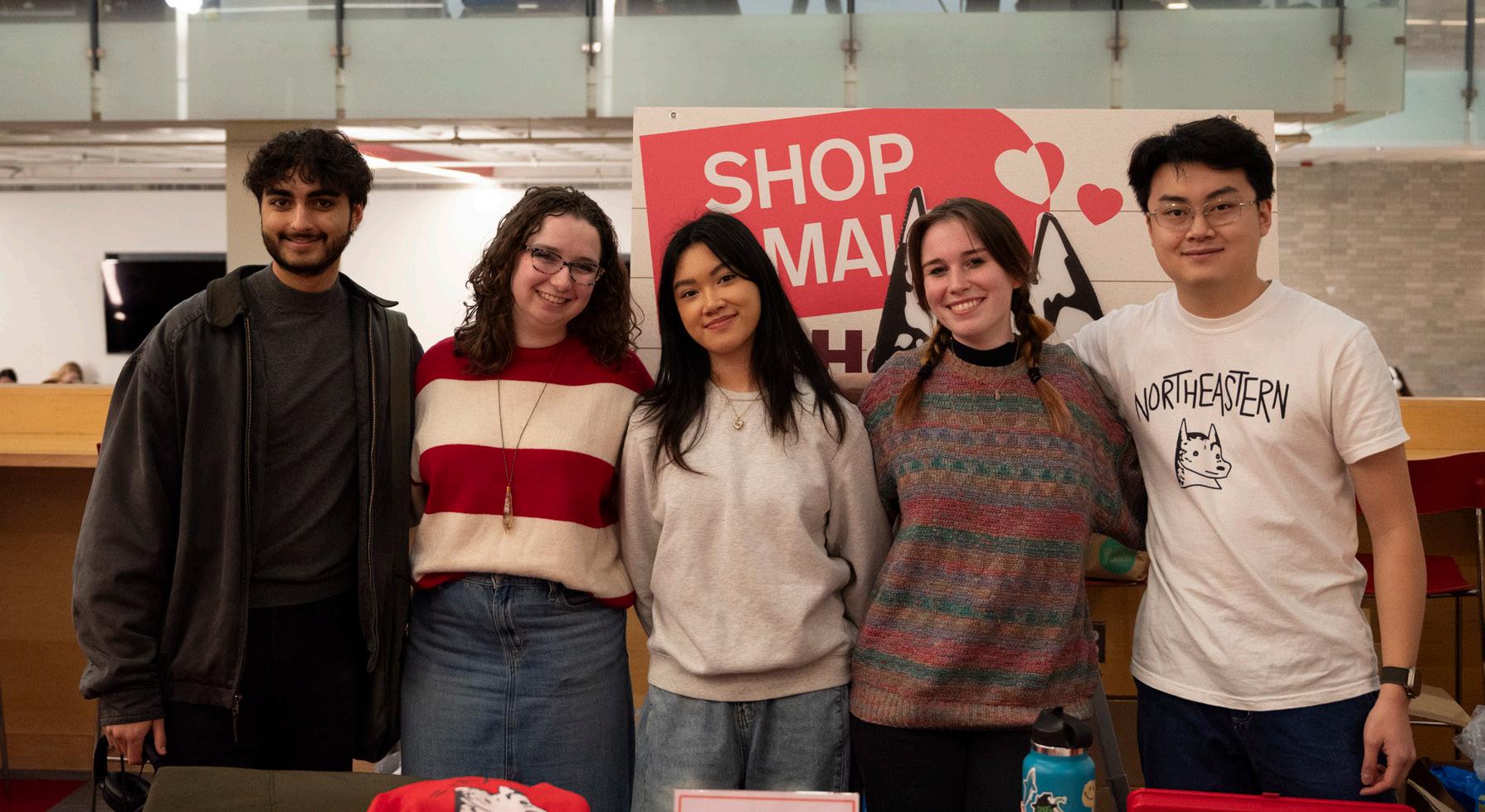
KAYLA GOLDMAN AND PALOMA WELCH News Staff
When picturing Northeastern’s mascot, many students may conjure an image of a powerful Husky named Paws. But some students may have another husky in mind.
The lines are often squiggly. Its ears are a little more rounded. But the quirkiness of Hoosky has won the hearts of many Northeastern students.
Hoosky is a merchandise brand founded by Northeastern students that sells apparel featuring their logo — a cartoon husky. Though it began as a clothing and merchandise brand, Hoosky has created a name for itself by promoting its business with limited-edition sticker drop events across campus encouraging people to purchase from the website, which began in March 2024 with a St. Patrick’s Day-themed Hoosky.
Who is Hoosky? Meet the team behind the perfectly imperfect rendition of Northeastern’s mascot.
HOOSKY, from Front
But the origins of Hoosky go back further. The first drawing and idea of Hoosky was created in 2021 on a Discord server for the incoming fall freshman class of 2025 as a parody of Northeastern’s mascot, Paws.
“I just randomly made the Hoosky on my phone with my finger in two minutes — very humble beginnings,” said Hoosky CEO and co-founder Chloe Colipano, a fourth-year business administration and communication studies combined major.
Colipano founded Hoosky, along side Head of Operations Andrew Lau, a fourth-year business adminis tration major, and Director of Design and Communications Meagan Ellis, a fourth-year design major.
“We just wanted to have a community and then also have something to distinguish ourselves as Class of 2025,” Lau said. “It just really came out of the blue, and we just built all that.”
no said. “It was meant to be something to just promote school spirit and be a little bit of silly amongst our hardcore co-op culture.”
The Hoosky team consists of 11 staff members who hold a variety of roles, including social media, communications and design of the stickers. Past sticker designs have included a Mona Lisa-inspired Hoosky, a coquette Hoosky and a Beanpot-themed Hoosky. Emma Rensin, a first-year

Sticker drops — originally inspired by the Instagram account @petr_the_anteatr, a parody of the University of California, Irvine’s anteater mascot, Peter — take place every Tuesday and feature 100 to 200 free limited-edition Hoosky stickers. The team posts the time at which the drop will take place on its Instagram story Tuesday morning, and at that time, the on-campus location of the drop is posted.
“Hoosky is a parody merchandise brand, like an offshoot of Northeastern a little bit. It’s meant to be very lighthearted, maybe meme-y,” Colipa-
biology major, has worked for the design team since the beginning of the fall 2024 semester.
“It’s already a really proud moment for me to walk around campus and see people with stickers that I’ve designed,” Rensin said.
The Hoosky community is well known on campus, and it has become a way for students to bond and form connections.
“Something we’ve noticed is that there is a community that’s rallied
behind Hoosky, and it’s super heartwarming and wholesome to see people say that Hoosky is like their version of school spirit,” said Maddy Chang, a second-year business administration and design combined major and the head of creative marketing for Hoosky. Hoosky has collaborated with many organizations and groups on campus, like the Resident Student Association and the pep band. The brand also designed jerseys for the club spikeball team and merchandise for parents at swim and dive meets. Notably, though, Hoosky is recognized for its collaboration with the Office of Prevention and Education at Northeastern by making a parody of its sexual resources program “Frisky Husky” to promote sexual health and awareness.
“I think that was one of my favorite drops last semester, just because it was a way for us to help spread awareness but also work with Northeastern in a way that sends a positive message,” said Hoosky Content Manager Michelle Liu, a second-year business administration and psychology combined major.
Moving forward, the Hoosky team hopes to expand the range of apparel it offers. But for first-year biochemistry major Liliana Mckenzie — who has collected six Hoosky stickers — Hoosky is an exciting way to showcase school spirit.
“I think Hoosky is an interesting way to bring a community of people together on something that can bring you a little joy in your everyday life,” Mckenzie said.
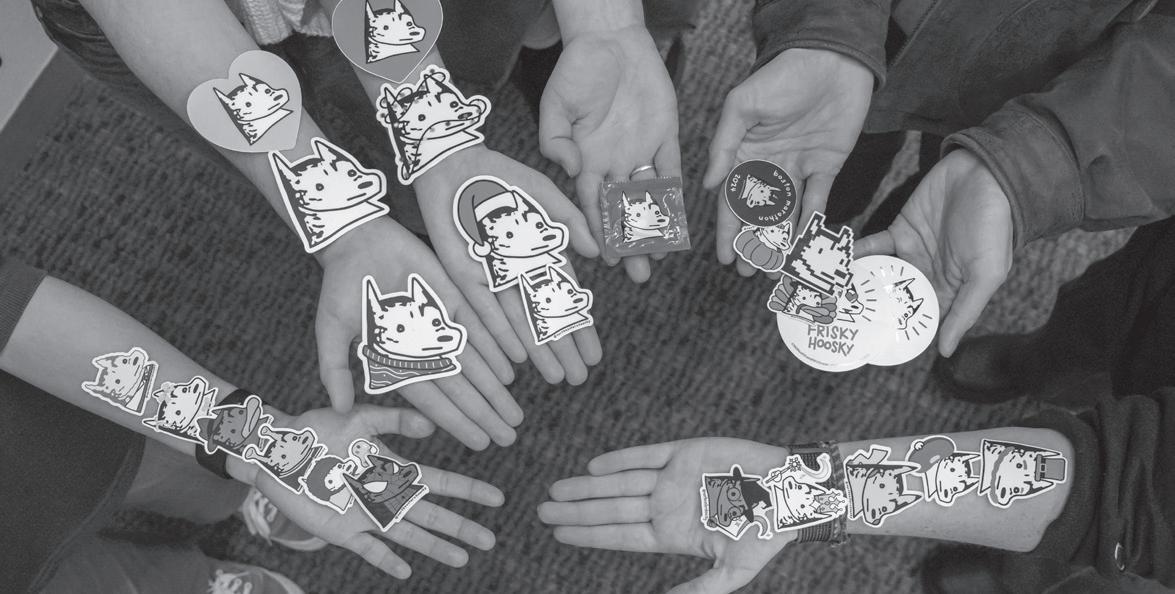
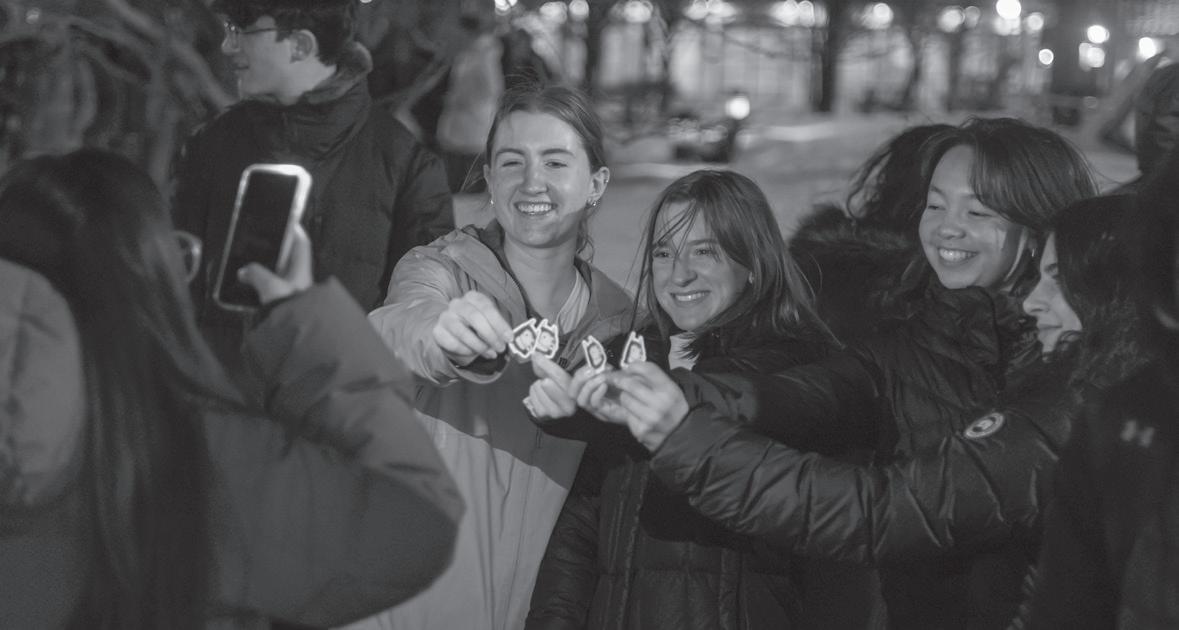

CO-OP, from Front
“What many of the hiring freezes mean is from now to the end of their fiscal year, [there will be] no new positions until their budget renews,” the coordinator said. They explained that budgets are renewed in the summer in preparation for the start of the new fiscal year in October. Therefore, many companies are unsure what the budget will look like for the fall and whether they will be able to accommodate co-ops.
Recently, Boston University, Harvard and the Massachusetts Institute of Technology, or MIT, were among a slew of employers who narrowed
their budgets in anticipation of federal funding cuts enacted by Donald Trump’s administration. Dozens of Northeastern co-op positions are offered through institutions affiliated with universities that are experiencing hiring freezes or slowdowns.
MIT and Harvard co-op positions, including Solve at MIT, the MIT BioMicro Center, the MIT Lincoln Laboratory, Harvard Medical School and Sabatini Labs at Harvard, are still accepting applications on NUworks as of March 19. It is unclear which positions may be impacted by hiring freezes and slowdowns.
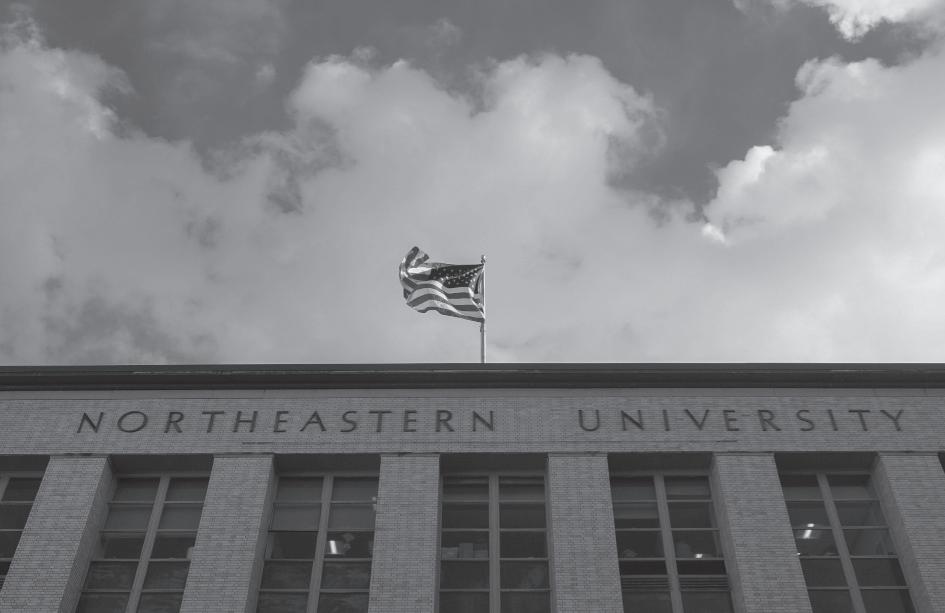
In response to a request for comment about available co-op positions on NUWorks, David Granchelli, the manager of MIT Lincoln Laboratory, wrote, “We cannot comment about your inquiry.”
In addition to job opportunities, Breghilyn Cheska Bagalso is concerned about how research teams will respond to the Trump administration’s onslaught of threats to diversity, equity and inclusion, or DEI, policies. Funding cuts to research the Trump administration says is DEI-related have forced many federally funded initiatives — including Northeastern-based research — to adapt. The coordinator said most co-op positions related to DEI are organization-based rather than federally funded, so if “the organization still holds those values, which we hope and wish that they do, that position will stay open.”
However, this differs if companies or organizations hosting DEI-related positions are federally funded.
“The challenge then becomes if it’s an organization that does have federal ties, … are they proactively ‘falling in line’ with this new, harsher language, or are they willing to hold firm on what they’ve had in place and what they believe in already?” the coordinator said.
The federal government also enacted a hiring freeze for federal
positions Jan. 20, including all executive departments and programs that have co-ops. Students previously had the opportunity to work within the executive branch, but those positions are now in jeopardy.
The uncertainty around funding and hiring challenges have caused some employers to pause and unpause their hiring patterns over the past several months. In an email written to Northeastern co-op applicants obtained by The News, the United States Attorney’s Office wrote March 14 that “the intern/ Co-op program at the [United States Attorney’s Office] is no longer under a hiring freeze.” Applicants had previously been told that the United States Attorney’s Office was no longer hiring.
Anya Khemlani, a second-year computer science and behavioral neuroscience combined major, is currently applying for co-ops and primarily looking for lab or biotech opportunities. Khemlani had spoken with a previous employer, an academic lab at Cornell, about a potential co-op opportunity.
However, she was informed in early February that the lab could no longer employ her as a co-op because of National Institutes of Health, or NIH, funding cuts. Instead, they offered her an unpaid volunteer position over the summer.
The Associated Press reported universities across the country have enacted hiring freezes because of the “financial uncertainty” due to threats to research grant funding. On Feb. 25, a federal judge blocked Trump’s attempts to impose a federal funding freeze, and a second judge extended this block March 6. The new NIH policy would limit indirect costs, or money for administrative costs like rent or heating, to only 15% of all grants, which is significantly less than what is currently given to various institutions, according to NPR.
Bella Kaplanovich, a third-year neuroscience major, is currently searching for her second co-op and hoping to find a position in clinical research. She said she had learned information about hiring freezes and funding cuts from her coworkers and past managers, but not from Northeastern.
“It’s just tough because it’s not Northeastern’s fault. I think it’s a matter of action planning with people, helping them understand what their options are,” Kaplanovich said. “We’re all trying to be so diplomatic about it and not talk about federal changes, but the whole reason an institution exists is for the pursuit of students, and if students aren’t getting what they came here for, the federal politics doesn’t matter. It’s just a matter of the student experience.”
Nearly a year and a half after earning union certification, graduate student workers are still negotiating with the university, leading some union members to weigh a strike.
Following a surge of organizing in 2022 and 2023, Graduate Employees of Northeastern University-United Auto Workers, or GENU-UAW, won its certification after a vote in September 2023. The union then announced its bargaining committee and has been in negotiations with the university since.
President Donald Trump’s second administration has complicated union negotiations nationwide after it fired a National Labor Relations Board member Jan. 27. The Trump administration has also cut funding for research and threatened visas — a blow to higher education institutions.
After 21 bargaining sessions with representatives from the university, Sarah Gillespie, a computer science doctoral student and member of GENU-UAW’s bargaining committee, said the union is growing increasingly frustrated, prompting some members to push internally for a graduate worker strike. To approve a strike, the unit members
must propose it, then its bargaining committee must authorize a full GENU-UAW strike vote. If the union votes overwhelmingly in favor — or a two-thirds majority vote — union leadership would be empowered to call a strike.
“Our international student worker community brings so much value to the university, to each other,” Gillespie said. “And I feel sad that the Trump administration has made it so that they’re scared to organize for better working conditions and worry that that might affect their visa or their job potential when it is just as legal for them to organize as domestic students.”
More than 64% of Northeastern’s graduate students are international, and international students make up 65% of GENU-UAW’s bargaining unit, according to GENU-UAW’s March 11 bargaining update. The union advocated for enshrining equal protections for international Graduate Student Workers, or GSWs, “regardless of a GSW’s citizenship and immigration or documentation status” into their contract, while the university’s Dec. 20, 2024, proposal argued this clause is unnecessary.
Moreover, the union wrote that “The University shall not permit any federal immigration agent to enter University property,” to which the
university responded in a comment, “Federal law requires site visits by federal immigration authorities. We cannot agree to violate federal law.”
In a March 11 union counter-proposal, the language was altered to “The University shall not permit any federal immigration agent to enter private University property, except as required by lawful subpoena or lawful order.”
The university did not respond to request for comment from The News.
Also on the bargaining table are protections for transgender, nonbinary and gender-nonconforming individuals. In an August 2024 proposal on the Prohibition Against Discrimination and Harassment, the union wrote, “The university and the union share a commitment to support transgender, non-binary and gender nonconforming members of the campus community with navigating the policies and practices of the University during a gender transition, as well as to assist University.”
The university’s Feb. 15 counter-proposal used different language, saying it will commit to protecting students from discrimination due to their “gender identity or expression.” The university wrote that it would update name and gender information at the request of a GSW,
“consistent with applicable law and federal funding requirements.”
The university and union have not yet agreed on economic proposals, such as compensation and insurance benefits for union members. The union proposed Aug. 26, 2024 a minimum annual stipend of $60,000 and a minimum hourly pay of $57.69.
“The Union admitted that its $60,000 stipend number was based upon an MIT wage calculator that produced cost of living estimates for full-time employees who work 40 hours per week in the Boston area,” Northeastern wrote following the Aug. 26 bargaining session.
The university’s proposal Nov. 18, 2024 lists a minimum stipend of $43,000 and a guaranteed hourly wage of $18. The university agreed to provide health insurance, including dental insurance, exclusively for full-time graduate students, whereas the union’s proposal would also guarantee health insurance to GSWs on co-op.
“When I’ve talked to UAW staff being like, ‘Can I get a sanity check? This feels really tough. How are we doing compared to other unions, in your experience?’ This is my first union,” Gillespie said. “They say that Northeastern is one of the toughest employers they’ve worked with in the higher education realm.”
As demonstrators collected discarded signs and picked up trash on Boston Common following a rally for Ukraine Feb. 23, a handful of activists, academics and community leaders gathered on Parkman Bandstand. Among them, exchanging words of gratitude in Ukrainian with her compatriots and passing around homemade deruny (a traditional Ukrainian potato pancake), was Ivanka Roberts, president of the nonprofit Ukraini-

or UCCN. UCCN took the lead in organizing the Feb. 23 rally — as well as nearly every other Ukraine-related rally in Boston since its founding. In early 2022, Roberts and a group of Ukrainian-Americans passionate about their culture founded UCCN to foster community among fellow Ukrainians and share Ukrainian traditions and history with Americans. Roberts is originally from Lviv, the cultural capital of Ukraine, and while she has lived in the United States for over a decade, she maintains a strong connection to her homeland. Roberts said this connection was a motivating factor for her to get involved in
“For me, [activism] was coming back to my roots,” Roberts
“When you first come here, you learn how to live in the new country. You cover your four pillars of work, housing, family and friends, but eventually you’re in need of your own circle, and this is usually culture, traditions and something that relates to you and your people. That’s how I was lucky enough to be surrounded by many people who care deeply about Ukraine, and we united and made this organization, UCCN.”
While UCCN’s current work is largely centered on spreading awareness about the war and supporting the
war effort, Roberts said its original goal of sharing and celebrating Ukrainian culture is still at its core.
“[UCCN] was co-founded before the full-scale invasion with the goal of uniting community around Ukraine and to have everybody around us fall in love with Ukraine and see what we can show the world and offer to the world. That is why we are a cultural center specifically,” Roberts said.
As the leading organization by and for Ukrainians in the Boston area, UCCN often attracts volunteers who lead various other groups and projects.
Kyiv native Daria Bogatova is a doctoral student in biology at Boston University and a volunteer organizer with UCCN, as well as president of the nonprofit Mriya. Mriya sends medical supplies and other humanitarian resources to Ukraine in cooperation with military units. Bogatova said UCCN helped her gain support when she founded Mryia.
“We started during the full-scale invasion and it was me, my husband and my friend,” Bogatova said.“We realized that we cannot do much as individuals, so we needed to found the whole nonprofit here in Boston. People [in Boston] just started coming up so people just came together and there was the Ukraine Culture Center of New England for support.”
Bogatova said that in the shadow of larger nonprofits like Nova Ukraine and Razom, which work on different scales and in different forms, organizations like Mriya and UCCN must be recognized for the niche that they
NU dining may limit eggs amid shortage
Signage posted in the Northeastern dining halls March 13 reported that they may not have eggs available in the coming weeks due to an ongoing nationwide shortage.
“Due to supply shortages, egg availability may be limited in the coming weeks,” the signs, posted in the International Village and Stetson East dining halls, read. “We are working closely with our suppliers to improve availability.”
The sign is prominently displayed at the front of the “Asian Kitchen” in International Village, which doubles as an omelet or “Eggs Your Way” station most days.
With a nationwide spike in avian influenza, or bird flu, the entire country has seen egg shortages and price surges. Before the spread of bird flu, eggs averaged $2 a dozen; in February, it cost around $5.90 a dozen. Eggs are now 60% more expensive than in 2024, and prices continue to climb.
Egg prices rose more than 10% from January to February this year, according to Forbes. Bird flu has wreaked havoc on the entire market with prices expected to climb by over 40% by the end of the year, according to the U.S. Department of Agriculture.

serve and their local impact.
“Every single person matters, and every single nonprofit matters,” Bogatova said. “There are larger nonprofits, much larger than we are, but we have our own niche of sending medical aid … [UCCN is] more cultural and they work on more events. Every individual effort matters.”
For many Ukrainians, like UCCN volunteer Nodira Uhlanova, originally from the Russian-occupied Crimean Peninsula, this activist community helps her feel connected to Ukraine while living abroad.
“I try to be everywhere when it’s Ukraine, when [UCCN] needs support,” Uhlanova said. “This is because I want to be part of these people who help Ukraine make [a better] future. I hope one day, we can all go back to Ukraine and we can celebrate a lot for a long time.”
After officially entering the fourth year since Russia’s full-scale invasion of Ukraine, Roberts said she hopes UCCN demonstrates Ukrainian resilience and strength to the world through its events.
“This is the third year of fullscale invasion, 11 years of war, and especially with everything that’s happening right now, we need to be visible. We need to be very loud, very united to remind the world that they have the voice and the say, and freedom is important,” Roberts said. “For me, it is very important that people understand that helping Ukraine is not just about a country. It’s about so much more. It’s about the values that we share, especially here in the United States, that it is also a country of the brave and the free.”
The Department of Education announced March 11 that it plans to cut nearly half of its employees, taking its total staff from around 4,133 workers to 2,183. On March 20, President Donald Trump signed an executive order that would “begin eliminating the federal Department of Education once and for all,” instructing U.S. Education Secretary Linda McMahon to begin dismantling the department.
In a March 6 update to Northeastern’s “Navigating a New Political Landscape” FAQ page, the university wrote that a reduced or dismantled Education Department could disrupt or slow down the administration of some financial aid programs. Since taking office, Trump has repeatedly signalled that fully dismantling the department is his end goal. Taking this step, however, would require an act of Congress.
Divisions within the Department of Education hit hardest by the recent cuts include the Office for Civil Rights and the Office of Federal Student Aid. Cuts in these offices could lead to slower responses to civil rights complaints. It is also expected that financial aid programs managed by the department may suffer due to administrative shortcomings.
Home to 35 colleges, universities and community colleges, Boston is a scholarly hotspot — not just a college town, but a college city. With such a dense student population, there’s bound to be healthy rivalry between bordering institutions.
Insight from three of Northeastern’s closest neighbors reveal how the university is perceived from the outside.
“You guys are basic, I guess, but cool,” said Maxwell Pauls, a second-year commercial dance major at Berklee College of Music, located on Boylston Street. “I think very much of VSCO girls and lacrosse boys.”
Established in 1945, Berklee’s Latin motto, “Esse quam videri,” translates as, “To be, rather than to seem.” With this, Berklee emphasizes an appreciation for music history. At the same time, it encourages students to take stock of artists today and take part in the making of contemporary music history. Comparatively, in the eyes of some Berklee students, Northeastern lacks creativity.
“I kind of get a little bit of tech bro or tech gal vibes,” said Salem Pace, a fourth-year performance and composition major at Berklee. “Maybe a bit more of the quote-en-quote ‘normie’ vibe.”
Berklee is the largest independent college of contemporary music in the world. Northeastern is a research institution home to a more STEM-oriented crowd, with the College of Arts, Media and Design being the smallest college under the university’s umbrella.
“One of the images I have is, like, tech, business — wearing a suit and tie on a normal day,” said Liz Meier, a third-year music production and engineering major at Berklee.
The Berklee perspective isn’t entirely bleak — Northeastern does have one thing going for it.
“I love Wollaston’s,” Meier said. “You guys have great sandwiches, and therefore, you are great.”
Wentworth Institute of Technology
Meanwhile, down the road on Huntington Avenue, Wentworth Institute of Technology students balanced admiration with cynicism.
“What I’ve heard a lot is that people come to Wentworth because they were rejected or waitlisted from Northeastern,” said Macey Perez, a first-year architecture major.
A friend of Perez echoed the same tongue-in-cheek sentiment.
“It’s, like, the Northeastern rejects — me included,” said Pamely Saldana, a first-year architecture major.
medical facilities. Schools in the consortium also give students the opportunity to take up to two courses per semester at any other COF for equal credit. Members include Emmanuel College, Massachusetts College of Art and Design, Massachusetts College of Pharmacy and Health Sciences, Simmons University and Wentworth Institute of Technology. It is unclear whether Northeastern was ever invited to join the consortium, which formed in 1996.
“I feel like it’s something to brag about. Like,
MassArt students skewed more toward the Berklee perception of Northeastern.
“Whenever I’m on your campus, I feel like I’m out of the bubble that MassArt provides for our students because MassArt just has such a highly queer population,” said Katelyn Pimenta, a fourth-year illustration major. “I’d say students are a lot less focused on self-expression [at Northeastern]. The career we’re going towards is intrinsically related to self-expression because we’re artists, and a lot of students at Northeastern just don’t have that same connection between their career and how they express themselves.”

Northeastern’s exclusivity is a point of contention.
“I’ve heard that people think Northeastern students think they’re so much better than us because they’re not a part of the Colleges of [the] Fenway,” Saldana said. “They’re like, ‘Yeah, Northeastern didn’t want to be a part of it.’”
The Colleges of the Fenway, or COF, is a consortium of five Boston institutions that share resources such as dining halls, research and
‘Oh, I go to Northeastern,’” Perez said. “Northeastern is a whole different world.”
Massachusetts College of Art and Design
Founded in 1873, Massachusetts College of Art and Design, or MassArt, is one of the nation’s oldest art schools. As the creatives on Huntington Avenue,
Co-op, however, was a major selling point.
“I think [at MassArt], there’s a dense bubble of art students who aren’t thinking about what they’re doing after graduation — kind of including me,” said Genie McDonough, a third-year studio for interrelated media major. “Northeastern seems a lot more career-focused.”
With 97% of Northeastern students employed or in graduate school within nine months of graduation, MassArt students feel their futures are more uncertain.
“There’s a finite goal in mind, whereas here, it’s like, ‘I’m gonna find a job…one day,’” said Gracie Plaza, a third-year dual major in sculpture and studio for interrelated media.
Pimenta agreed on the advantages that Northeastern’s long-term opportunities present.
“I know that co-op is, like, a fiveyear program, and I think that’s really interesting. A lot of Northeastern internship and co-op models are things I envy about your school — how network-oriented it is,” Pimenta said.
While some Northeastern students remain in school for five years due to co-op, it’s possible to graduate in the typical four.
Regardless of graduation timeline, some Northeastern students find themselves anxious in the face of professional pressure early on.
In Plaza’s personal life, the career-driven nature of the university breeds a certain kind of tunnel vision. Plaza pointed to her ex-boyfriend, a student at Northeastern, as an example.
In the midst of their breakup, “he said I wasn’t instrumental to his success,” Plaza said.
In the eyes of MassArt students, ambition at Northeastern also extends to the ice.
Beyond the co-op program, “A lot of what I see from Northeastern is, just, like, emphasis on hockey and sports,” McDonough said.
“I’ve been to a few games. None of which you guys have won,” Pimenta said. “The Beanpot was really brutal.”
While Pimenta exaggerated in her remark, the men’s hockey team’s performance has declined in comparison to the 2023-24 season, with decreases in overall records and conference records, as well as scoring averages. To its closest neighbors, Northeastern has earned the reputation of a land of normies in business casual. What the university lacks in 2025 Men’s Beanpot titles, it makes up for in sandwiches, career readiness and perceived prestige.
LAILA GUZMAN GRIFFIN News Staff
For Laura Gersch, election night last year was horrifying.
Gersch, a 10th grade English teacher at Boston International Newcomers Academy, or BINcA, a Boston Public School in Mattapan for English learners, spent the night anxious that she would wake up the next morning to news that Donald Trump had been announced as the 47th president of the United States. Her anxiety wasn’t for herself — it was for the safety of her students under the new administration, many of whom are immigrants and refugees.
Gersch’s fears quickly materialized. During Trump’s first week in office, his administration swiftly enabled immigration authorities to make arrests in schools, churches and hospitals, formally considered sensitive locations safe from arrests.
Videos of U.S. Immigration and Customs Enforcement raids in Boston began circulating on social media and soon reached Gersch’s classroom. As a teacher and immigrant herself, she has taken on the responsibility of keeping her students focused despite the impending dread of new policies.
“I tell them school is a safe place. We’re going to be okay. We can protect you,” she said. “All of which is not true.”
Every day, Gersch navigates teaching English to students from over 40 countries in the wake of political instability under Trump’s presidency.
“I think this is just very confusing for some students,” said Katrina Newfell, a high school program specialist at BINcA. “It has been very obviously upsetting.”
Cynthia Carvajal, the director of Undocumented and Immigrant Student Programs at the City University of New York, reiterated a similar sentiment.
one of their teachers.
presidency brings to her students, Gersch refuses to shy away from political discussions.
A recent project in Gersch’s class asked students to identify the elements necessary to recognize a dystopian world, a nod to Ray Bradbury’s 1953 novel “Fahrenheit 451,” the class’s current assigned reading. “Citizens who have only known their society fear the often unknown
from places overrun by war, gang violence or political turmoil.
“Many of the students who are here aren’t here because they think the United States is awesome. They’re just here because the place where they’re coming from is dangerous, scary, not manageable or all of the above,” she said.
Gersch began her career in translation and interpretation but
an, Arabic and Vietnamese.
Gersch embraces honesty with her students. She often tells them that getting a job or pursuing higher education can be more difficult for migrant students, especially if they’re undocumented. But she also encourages them to pursue their goals.
Though she can be tough with her students, she is patient and fair.

“The combination of the first Trump administration, the COVID pandemic and now the second Trump administration can be so emotionally and mentally debilitating for young immigrant folks who are just trying to get an education and participate civically, economically or socially in this country that they call home,” Carvajal said.
Despite the stress another Trump
outside world,” wrote one student in cursive sharpie.
Now 51, Gersch spent her childhood hopping from country to country. Born in Munich, a city she still considers home, she came to the United States to study anthropology at the University of Massachusetts Boston. Unlike many of her students, she was not running
yearned for less solitary work. She soon recognized that teaching was a powerful way to learn about others, particularly with multilingual students who could teach her about unfamiliar places. With English, Spanish, Italian, German, French and Haitian Creole already under her belt, she is focused on mastering the remaining languages spoken by her students, like Ukraini-
“Ms. Laura The Logical,” reads a sign near her desk. Her day begins at 5 a.m., where she completes her daily Duolingo lesson. After school, she organizes a Haitian Creole class for staff in the building, where students themselves teach. By 8 p.m., she is able to grade work and finish any additional administrative tasks. On the rare occasion she must miss a day of school, her students know well in advance and have pre-prepared material to tackle.
Although she didn’t initially envision herself teaching, there is nothing she’d rather be doing.
“We’re in it together,” Gersch said. “In spite of all the pressures that come from the outside, we all have to endure this similarly.”
ELEANOR HARDY News Staff
As the season shifts and the weather warms, the Isabella Stewart Gardner Museum unveiled its newest exhibition, “Waters of the Abyss: An Intersection of Spirit and Freedom” by Fabiola Jean-Louis Feb. 27. Running through May 25,

the exhibition includes over 50 pieces, spanning the museum’s three rotating exhibition spaces.
To celebrate the opening, the museum hosted a discussion held
by Jean-Louis Feb. 27. The central theme of the discussion was driven by the question: What lies at the center of Black freedom?
Born in Haiti, Jean-Louis explores Haitian spiritual syncretism and tradition in her works. Haitian spirituality evolved into a pluralistic and dynamic form of resistance for Black Haitians.
Haitian Vodou encompasses a wide range of spiritual traditions that originated from African practices brought to the island during the period of colonialism and slavery. During the discussion, Jean-Louis described the function of Vodou to create unity while forced behind a mask of Catholic symbolism.
The exhibition featured Jean-Louis’s dualistic application of papier-mâché, which ranged from intricately decorated sculptures adorned with shells to paintings that offered allusions to the past and future of Haiti. For Jean-Louis, the paper’s universal utility and historical significance provide an opportunity to redefine her identity.
“It’s so emotional. I’m just completely immersed in the beauty of her art and how intricate it is,” said visitor Riya MacKenzie, a local photographer. “I feel very drawn to the art, the water and the colors of
the seashore but also to how she’s lending her spirituality to her art.”
Jean-Louis sources raw materials from her neighborhood of Little Haiti in New York City, creating paper pulp to sculpt and shape permanence from what are otherwise transitory materials, often resembling natural surfaces such as gold, metal and rock. She also incorporates into the works ornate shells, sea glass and reflective surfaces — elements that hold sacred significance in Vodou.
Multimodality in Jean-Louis’ work opens up the generative potential of art to “bridge the body and spirit,” creating new stories and spaces for reflection, she said during the discussion. Her papier-mâché constructions merge reverence and reflection, operating within and across nonlinear understandings of the world and beyond.
“It feels surreal to see Vodou depicted in such a public way that is also reverential,” said Nathanial Gabriel, a visitor and local artist. “I’m Haitian, and my family also practices Vodou, so this is what I’ve grown up with and seen.”
Gabriel has previously experienced Jean-Louis’ “Before Yesterday We Could Fly: An Afrofuturist Period Room” exhibition at the Metropolitan Museum of Art in New York

different mediums of art,
to intricate clothing.
City in 2021. Jean-Louis became the first Haitian woman to have a solo exhibition at the museum.
For Gabriel, something resonant within Jean-Louis’ works and during the discussion was her understanding of human spirituality.
“The spirit — our spirit — wants to participate in the human experience,” he said. Jean-Louis describes the human spirit as essential in
merging past and future, existing within a vast cosmographic plane of existence.
“It’s like coming home, like she said,” Gabriel said. During the discussion, Jean-Louis invited the African and Haitian diaspora to join body and spirit in a shared reconnection.
At the heart of the exhibition stood “Lwa,” a gilded papier-mâché and mixed-media effigy surrounded by candles. The figure presented a sword inscribed with the phrase “PRAN TET,” or “take heads,” a rallying cry from the Haitian Revolution.
“Especially during times like these, when we’re facing a lot of political heaviness, Haitian people have a lot that people can learn from,” Gabriel said.
For visitor and artist Alana Borges-Gordon, Jean-Louis’ works “bring something that is super necessary to the world and the community.” Jean-Louis’ art is a dedication to ancestors and a future call to action, each piece carefully crafted to reflect personal significance.
“She’s saying the quiet part out loud and the loud part even louder,” Borges-Gordon said. “Everything was hitting, resonating … I felt her words deeply in my spirit and in my soul.”
“Parade” began its limited twoweek run in Boston March 11 at the Emerson Colonial Theatre as part of its second-ever national tour.
While “Parade” was originally written in 1998, the national tour is based on the 2023 Broadway revival, which was nominated for six Tony Awards and won two, including Best Revival of a Musical.
“Parade” follows the true story of Leo Frank (Max Chernin), a Jewish superintendent of an Atlanta pencil factory who was wrongly convicted in 1913 for the murder of 13-yearold factory employee Mary Phagan (Olivia Goosman). During his journey, Leo’s relationship with his wife, Lucille Frank (Talia Suskauer), is tested before he is ultimately kidnapped and lynched for the crime.
Chernin did not disappoint in his performance, fully encapsulating Leo’s emotional journey from a cold, distant and angry man to a loving, vulnerable husband and fighter for justice. This was especially prevalent in a scene where Lucille visits Leo in prison, and he brushes off any consoling sentiments she has to offer. Chernin’s expressive outbursts and aggrieved mannerisms made the scene, showing Leo’s personality and internal conflicts. Chernin’s commitment extended so far as to stay in character through the show’s 20-minute intermission, as Leo paces and lies on a bench in his jail cell, symbolizing the two years between the play’s first and second acts.
Suskauer stood out in her flawless portrayal of Lucille’s compassion, resilience and devotion. Delivering multiple solos, like in “What Am I Waiting For?” and “You Don’t Know This Man,” Suskauer’s strong stance and emotionally charged vocals established Lucille’s courageousness and loyalty.
Chernin’s and Suskauer’s talents were best showcased together in the second act during their duet, “This Is Not Over Yet.” The two effortlessly embodied the roles of Leo and Lucille as they reconnected over a picnic in Leo’s jail cell after bribing the guard, finally showing their appreciation and love for one another. The strength of their vocals magnified their chemistry as they gazed passionately at each other.
The show’s score successfully emphasizes tense moments while contributing to the beauty of slow ones, proving why the original 1998 show won a Tony for Best Original Score. In songs like “The Trial: Hammer of Justice,” fastpaced, repetitive notes alternate from being a constant to swelling into more dramatic parts of the scenes. Other songs featured slow, delicate piano and string melodies in quiet moments of reflection, such as in “My Child Will Forgive Me,” during which Mrs. Phagan (Jenny Hickman), Mary’s mom, sings about her regrets for not being able to do more for her daughter.
The set of “Parade” maintained a focus on the story through a relatively simple set consisting of a raised platform at center stage with
a set of stairs and rustic wooden chairs and benches on either side. Semi-circular American flag banners lined the edge of the stage, while props such as United States and Confederate flags, woven baskets and lace tablecloths were used in an intentionally sparing way. Despite having an unchanging set, the show was never dull, seamlessly repurposing props and furniture to fit each new environment.
The most immersive on-stage element was the projections of real locations and people from the case in the background, allowing audience members to truly feel transported into 1910s Georgia. Pictures of key locations and projections of newspaper headlines helped fill in any extra context that the immutable set might have lacked. The peak of the scene-setting projections occurred in the second act, where photographs of the real hanging of Leo Frank were projected alongside the play’s portrayal of the hanging as the loud clang of a bell reverberated throughout the silent theatre.
Period-accurate costumes also contributed to the show’s successful realism. Many of the men wore three-piece suits with waistcoats or military uniforms from the time, while the women wore long-sleeve, collared blouses with long, flowy skirts, a belt and, sometimes, an apron. Accessories such as lace gloves and parasols for women and flat caps and bowler hats for men were also prominent.
Children’s fashion of the time was reflected through Mary and her
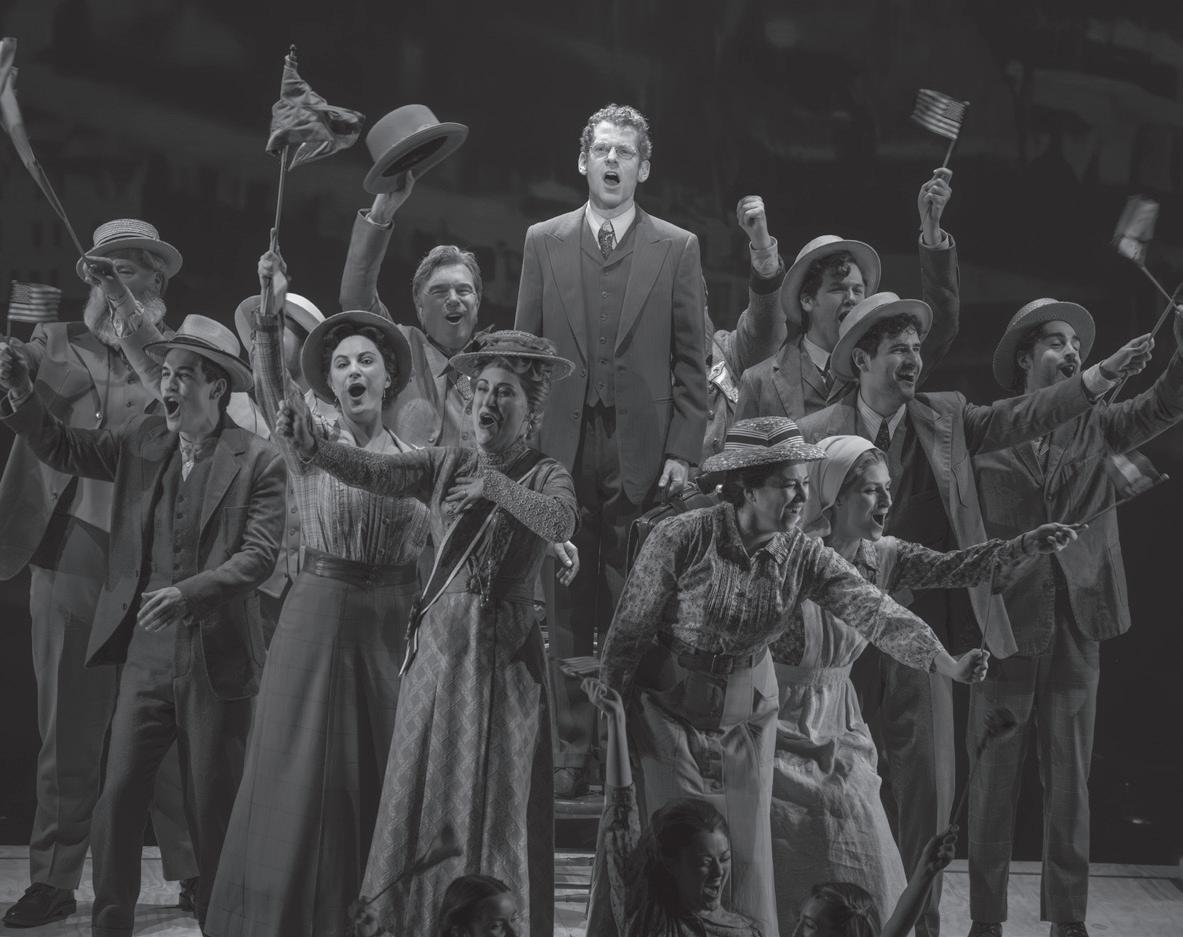
friends’ high-waisted pongee dresses consisting of one plain color and pattern. Mary’s magenta dress stood out among her friends’ duller red and green dresses and, coupled with the balloon she held throughout the show and her hair ribbon, highlighted her innocence as seen by the community.
The production’s blocking seamlessly moved a large cast across a small stage, creating smooth transitions between scenes and musical numbers despite a slightly cramped environment. The choreography, which included raising props with one arm, isolated movements, spins and hurried pacing skillfully portrayed the outrage of the townspeople convinced of Leo’s wrongdoing. At times, it felt awkward for those
not convinced of this. During a courtroom scene when witnesses testify against Leo, Lucille and Luther Rosser (Brian Vaughn), Leo’s lawyer, they are left simply sitting, looking neutral or at least annoyed. As a result, their reactions felt too tame at times compared to other scenes.
“Parade” left audiences with a powerful history lesson on one of the most influential American lynching and antisemitism cases of the time. In the show’s epilogue, projected words informed the audience that Leo’s case was reopened in 2019 and is still ongoing, emphasizing that while the show was over, the story is not.
“Parade” will be at the Emerson
through
RACHANA MADHAV News Staff
The ultimate college experience has different checkboxes for everyone. However, a college classic is live music: everyone’s favorite local band and a roommate or two up on stage playing the blues.
The music scene in Boston lacks a notable reputation. Many college bands are left without a venue to play in, leaving their music unheard. Meanwhile, music lovers float around the idea of a perfect music scene — to no avail.
Enter *junkyard.
Here, audiences are dazzled at every show. Attendees are greeted by actors who play clowns, giants or yetis; bands that play their hearts out to loving fans; and a team of students from Northeastern University and Emerson College to deliver everything music lovers could hope for.
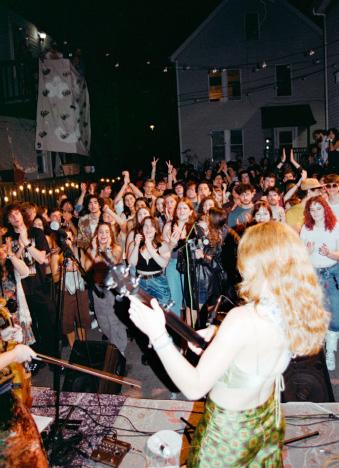
The Boston-bred live music venue was started Sept. 30, 2023 by Northeastern student Jeremy Serbee, a fourth-year politics, philosophy, and economics major. Serbee and co-founder Owen Silleck, a fourthyear film major at Emerson College, came up with the idea of *junkyard while in Serbee’s backyard shed, where they theorized of a music venue different from the rest.
At Northeastern, Serbee often felt lonely, hoping for more than the vacuum he felt existed in the live music scene.
“It’s a bit shielded,” Serbee said. “When I first got to Northeastern, I had trouble breaking into [the music scene].”
He traveled to other colleges around the Boston area, curious to see if they had what he was missing. While visiting a friend’s show, watching them perform in their college’s dining hall, Serbee was inspired — he knew the music community was what he needed to be surrounded by.
“It’s less about giving people a place to perform and more about giving a general audience more of a place to just be and thrive — really meet people and hang out,” Silleck said.
In an August 2023 Instagram post with the words “*junkyard now booking,” Serbee, Silleck and a passionate crew showed social media they were ready to put on a show. Featuring artists Dejima, the camgirls and JOBIE, the very first show less than a month after the initial post amassed an turnout of around 150 people, all of whom only brought more to the next one. *junkyard’s shows as of 2025 hold
attendance numbers of around 450 to 500 people, Serbee said.
Each show works to highlight and uplift a Boston band, picking from dozens of submissions through its booking form. Bands are chosen based on their general aesthetic and the theme of a particular show.
“I want bands to see us as something that’s reliable. Being communicative with the artists that we work with is really important to me,” Serbee said. “It’s always been a huge team effort. Everybody plays a really important role.”
The *junkyard team, composed of students with film, music and various media-related backgrounds, cultivates unique aspects of live music that most people have never experienced before.
A trip to *junkyard may include 6-foot-7-inch actor Quinlan Harp, a fourth-year visual media arts major at Emerson College, standing on stilts — resulting in Harp’s rendition of an 8-foot-tall figure — looming over audience members and performing comedy routines at *junkyard’s Halloween show: “Graveyard.”
“This past year, I’ve realized that surprise has been my favorite flavor,” Harp said, adding that the creative freedom to take an idea and run with it has been extremely fulfilling. Harp and the rest of the team bounce ideas off one another regarding goals for the shows and what they want it to look like. Silleck, now studying in Los Angeles for a semester, looks forward to the team’s so-called “Sunday Round Table,” where the *junkyard family of around 15 people meet up virtually to talk about goals, projects and future “bits.”
“Our crazies match each other very well,” Harp said. “We are providing a space with an odd air to it that you feel safe, and you feel like something could come out of the corner that just makes you smile.”
*junkyard hosts around six shows every year, each with a unique theme, music genre and antics from
to feel like they have a partner,” Serbee said, when considering what his hope for *junkyard is. “I want them to think of us as people who care.”
“It’s definitely one of the highlights of doing *junkyard, is being able to highlight these smaller bands that might not get platformed in this specific space otherwise,”

“We put a ridiculous amount of time and effort — and Zoom meetings — with all 15 of us into each show, And so that’s kind of why it happens so infrequently,” said Serbee, who finds that the infrequency of the shows only makes them all the more special. In addition to finding bands and designing sets, the team obtains permits through the city, specifically in Cambridge, and allocates outdoor spaces where it can build a stage.
A musician himself, Serbee is familiar with the lack of resources in his field. “I definitely want [bands]
yard, Silleck designs the website, posters and collages for each show, playing an enormous role in *junkyard’s branding. Silleck enjoys every part of what he does in curating the venue’s aesthetic. Aside from the work he does for the venue, he holds a deep love for its members and their impact on his life.
“The amount of friendships and seriously meaningful and beautiful relationships I’ve been able to form through *junkyard and around *junkyard — I really can’t overstate it,” Serbee said. “It has really made my college experience.”
15 and 16 before a show at Citizens House of Blues on St. Patrick’s Day.
Imagine the chaos of a rowdy frat party, only more Irish. Crowd members and half-empty drinks alike are sailing across a sea of paddy caps. Every time the band gets louder, so does the crowd, each trying to match the other’s energy.
It’s a quintessential St. Patrick’s Day party, and the city of Boston is invited.
Dropkick Murphys (and maybe a drink or two) was just what Boston needed March 14 to get riled up for a weekend of St. Patrick’s Day festivities.
The Celtic punk band has been a Boston staple since its formation in Quincy in 1996. At MGM Music Hall at Fenway, the band’s unapologetic pride for the city was on full display. The show was the first in a series of St. Patrick’s Day weekend concerts, with two more nights scheduled at MGM March

The Kilograms, featuring Joan Jett and the Blackhearts drummer Michael McDermott and The Mighty Mighty Bosstones bassist Joe Gittleman, opened the show, evoking a similar Boston energy to Dropkick Murphys with its topical songwriting. Between songs, the band called out President Donald Trump and rallied the crowd to “protect trans youth.” In a show of support for the LGBTQ+ community, The Kilograms’ members included a brief punk cover of Chappell Roan’s “HOT TO GO!”
Punk rock band The Menzingers followed with a blazing set of their own, showcasing a deceptive feelgood sound over equally topical lyrics in songs such as “America (You’re Freaking Me Out).” The band also dedicated a song to Boston, hyping up the audience. About halfway through The Menzingers’ set, the crowd could no longer contain its excitement for Dropkick Murphys, with one ampedup crowd surfer setting the scene for the rest of the night.
By the time Dropkick Murphys started their set with a cover of The Fureys’ “The Lonesome Boatman,” the energy was unmatched. Lead singer Ken Casey was undoubtedly proud to be back in Boston, leaning into the crowd and pointing the microphone toward them so they could sing along.
Alternating between originals like “The State of Massachusetts” and traditional songs such as “Johnny, I Hardly Knew Ya,” the band’s Boston pride and enthusiasm for Ireland were equally on display.
Enjoying every moment of the audience’s unabashed spirit, Casey praised the commitment of the floor crowd as the seated audience in the balcony looked on.
“You bring the energy and work hard so these people can enjoy the show,” Casey said.
For the most part, Casey welcomed the constant crowd surfing, but he called out anyone filming themselves while riding the wave and making it easier for security to catch them.
“They’re trying to catch you, so if you’re taking a f****** TikTok video, cut that shit out,” Casey said.
Dropkick Murphys didn’t hold back with any political statements of its own, railing against the “Make America Great Again” movement, or MAGA, and decrying the “f****** orange asshole” who currently serves as president of the United States. The band’s outspoken cry followed an altercation at a recent show in Clearwater, Florida, where Casey called out a fan wearing a MAGA hat and shirt.
Though Casey knew he was wading into controversial waters, he promised the Boston crowd he would never hold back from speaking his mind.
“You certainly don’t have to agree, but know this: We mean it from the
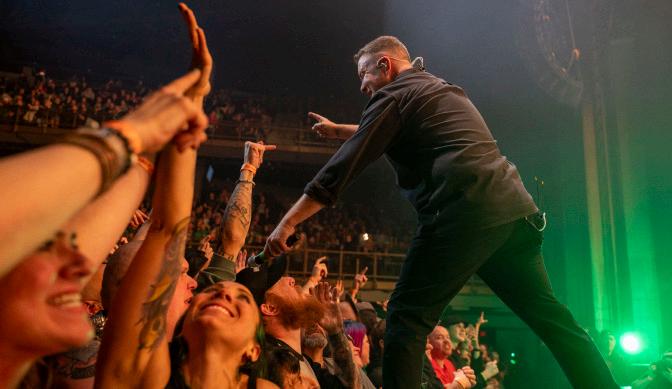
bottom of our heart,” Casey said. Casey’s comments were met with cheers from the crowd as Dropkick Murphys launched back into their endlessly energetic set. Fueled by Casey’s confidence, the crowd danced and moshed its way through the next few songs before pulling things back briefly for “Forever,” a solemn song about appreciating loved ones. Casey encouraged audience members to put their arms around each other as they swayed to the song’s steady rhythm.
As soon as “Forever” ended, however, the audience’s rowdiness was instantly revitalized, especially during “Tessie,” which comes from the Boston Red Sox’s longtime anthem, and “Rose Tattoo,” a song about Casey’s grandfather, which was re-released as part of a charity EP after the Boston Marathon bombing.
The band closed its main set with “Kiss Me, I’m Shitfaced,” a slower bar anthem that, in many ways, reflected the current state of the crowd.
Any devoted Dropkick Murphys fan immediately knew that wasn’t the end, though. Sure enough, the band came back soon after for an encore, playing “The Boys are Back,” which featured projected footage of Boston Bruins players fighting on the ice. Finally, the band ended the night with its biggest hit, “I’m Shipping Up to Boston.” The crowd reached an explosive peak as it sang along to the Boston anthem it had been waiting all night for.
As Dropkick Murphys thanked the crowd and said good night, they left the audience without any doubt in its mind that there was no better way to kick off St. Patrick’s Day weekend, especially in Boston.

JACK MASLIAH Contributor
IN W.B. YEATS’ “THE SECOND COMING,” THE 20TH-CENTURY POET DESCRIBES A WORLD “SLOUCHING TOWARDS BETHLEHEM,”
SYMBOLIZING A DESCENT INTO UPHEAVAL AND UNCERTAINTY.
In this interview of “Slouching Towards,” contributor Jack Masliah explores how the Northeastern College Republicans view President Donald Trump’s first 40 days in office — and how they defend his efforts.
Matt Cosentino is a fourth-year political science major and the current president of the Northeastern College Republicans.
This interview has been edited for the print edition of the newspaper. Find the full version online.
Masliah: The Department of Government Efficiency claims to have saved taxpayers $60 billion, but the number is actually closer to $9 billion. Is DOGE the proverbial slayer of government waste it was made out to be?
Cosentino: The concept of rooting out waste in the bureaucracy is generally good, and $9 billion isn’t nothing.
I do think the [current] effort is more about speed rather than only going after spending. You have to balance that. I think you have to go at it more with a scalpel than a hammer. That’s something that DOGE is going to have to learn on the fly here.
Masliah: The official White House account tweeted an AI-generated Time magazine cover of Trump wearing a crown with the statement “CONGESTION PRICING IS DEAD. Manhattan, and all of New York, is SAVED. LONG LIVE THE KING!” Do you take him at his word when he refers to himself as a “king?”
Cosentino: No, because I think he’s trolling. I don’t think he actually thinks that he’s a dictator.
I think the [artificial intelligence]-generated image thing is trolling, similar to what he did with Gaza. What he said before about the U.S. taking over Gaza, I think there’s a chance he was doing it to provoke a reaction to get Middle Eastern countries to do more. So, I wonder if it’s a similar tactic.
Masliah: You seem to be saying that Trump is simultaneously trolling but is also a master strategist here. If former President Biden were saying any of these things, would we
be giving him as much slack as you are giving Trump?
Cosentino: It’s really hard, personality-wise, to compare anyone to Trump, especially Biden. Normally, a lot of stuff that Trump says or seems to be wanting to do doesn’t end up materializing, and it’s oftentimes a tactic.
Masliah: On Russia-Ukraine, given that Trump’s objective is to put an end to the war, it follows that engaging with Vladimir Putin is a necessary, if unpleasant, reality. And yet the way in which Trump is approaching this issue: by saying that Ukraine should have never started it, by calling Ukraine’s President Volodymyr Zelenskyy a dictator — and yet refusing to call Putin one — seems unnecessary to me.
Why is Trump not calling Putin a dictator? Why is he not blaming Russia for the war they started?
Cosentino: As far as his unwillingness to call Putin a dictator, that’s clearly to try to get on Putin’s better side to try to negotiate. Having said that, it doesn’t help with Ukraine to accuse them of starting the war.
People can disagree as to how much we should be helping them or how much we should have helped them in the past, but the reality is that Russia invaded their neighbor for conquest and has done a lot of things where they’re hitting civilian-only targets.
Even if someone is against NATO expansion, to say it was provoked and to not lay any blame on Russia, I think that’s just a little bit of a dishonest way of describing how it started.
Masliah: Where’s the red line for you here? Let’s say Trump defied a Supreme Court ruling very explicitly. Is that something where you would say, “Okay, maybe we should be putting pressure on the Republicans for the good of the party, for the good of the country?”
Cosentino: Certainly.
That’s a pretty fundamental aspect of having a constitutional republic, and an important aspect of conservatism is to acknowledge that that would be wrong.

In this interview of our new series, “Slouching Towards,” contributor Jack Masliah explores how the Northeastern College Democrats are grappling with their party’s electoral failure — and if they are prepared to meet the moment.
Bledar Velic is a fourth-year political science and economics combined major and is the current president of the Northeastern College Democrats.
This interview has been edited for the print edition of the newspaper. Find the full version online.
Masliah: Back in October, I sat down for an interview with you in your capacity as the president of the Northeastern College Democrats. Much has happened since then, and I want to get an idea, just 40 days in, of what has surprised you.
Velic: What has surprised me the most has been the role of Elon Musk. I really thought that Trump would get sick of him because he seems really annoying. Trump is very big on personality and already got rid of Vivek [Ramaswamy] for being, in a sense, an annoying personality.
Masliah: It’s hard to overemphasize how angry the current Democratic Party base is right now. Congressional Democrats stand at an abysmal 40% approval rating with voters within their own party. These are really, really bad numbers, historically speaking. What is the reason?
Velic: It’s the lack of clear leadership from the party.
This is where my frustrations lie, too — we’ve scuttled to the middle so much that we’ve lost the ability to advertise for something consistently. When you think of 2016, Trump’s plans have been the exact same the whole time. He hasn’t really changed his message, but the Democratic Party has evolved and changed, and we’re becoming more moderate.
There’s a lot of confusion and a lot of, “Who the hell’s gonna lead us now?”
Masliah: Much of this interview can be distilled down to one question: Are the Democrats meeting the moment? In your position as president of the Northeastern College Democrats — are you meeting the moment?
Velic: I’d give the Democrats a 50-50 at the moment. Some are [meeting the moment].
They’re seeing these instances where the story can be made, and they’re jumping on it, and they’re making a platform for that, and there’s a lot of people with good instincts.
Masliah: And as a club, are you informing, preparing and organizing?
Velic: Since it’s still like right after [the election],
there’s not really much we can do in terms of organizing, a lot of that stuff is still being built out. But, we’re doing a good job, I think, of informing our members, of giving people hope and a sense of community — [to make the] Democratic Party not just into something people identify as, but [into] a place, like our club.
We’re very connected with local campaigns around here. In that sense, we’re doing a pretty good job, and we’re meeting the moment — we’re building a base that’s educated, engaged and ready to organize when the need arises.
Masliah: Many anti-Trump voters fell into a state of depression following the election. This has been followed by a sense of shock and numbness. What would your message be to those that have canceled their news subscriptions and buried their heads in the sand? To those who believe that the country is lost, and there is nothing to stop a descent into oligarchy or dictatorship?
Velic: I would say that’s exactly what they want you to do. There was this really viral Ezra Klein clip where he clips that Steve Bannon line, “muzzle velocity.” They want you to feel this way, like Trump can just do whatever.
And he can’t just do whatever. And we have to watch these developments and talk, and just through word of mouth, talk to other people and be like, he can’t do that.
And so you spread these things: [That] he is trying to build an image of a king or just [how Trump is] spamming everything out and having everyone forget about all the things he’s doing. If we make sure we’re paying attention to everything and catching everything and watching as it all fails, we then become more informed.
Everything starts at the individual level.
Jack Masliah is a fourth-year political science and philosophy combined major. He can be reached at masliahlitchi.j@northeastern.edu


SUNDAY, MARCH 23
Eon Dance Troupe Showcase
6:30 p.m. at the Fenway Center
Admission: Free
MONDAY, MARCH 24
Comedy show at Lucky’s Lounge
7:30 - 9 p.m. at 355 Congress St.
Admission: Free
TUESDAY, MARCH 25
Trivia Night at High Street Place Food Hall
6 p.m. - 8 p.m. at 100 High St.
Admission: Free
WEDNESDAY, MARCH 26
Men’s baseball vs. UConn
2:30 p.m. at Friedman Diamond
Admission: Free
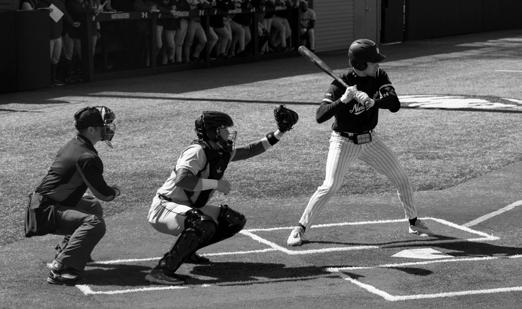
THURSDAY, MARCH 27
“Wicked” Screening
6:30 p.m. at Trident Booksellers & Cafe
Admission: Free
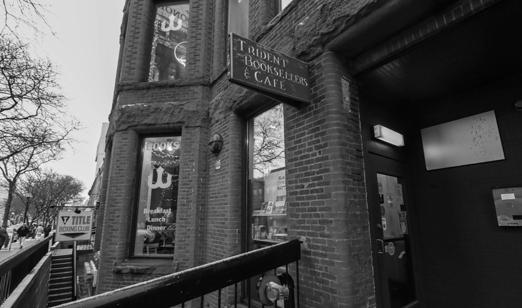
KAYLA GOLDMAN News Staff
For cross-country — or nordic — skiers, going to a city school means possibly having to give up their sport.
The HUski Nordic Club, founded by fourth-year and mechanical engineering major Ted Yee and fourthyear neuroscience major Greta Goldade in 2023, has become a home away from home for cross-country skiers at Northeastern. The club is not yet an official sports team, but it remains a goal for the future due to the possibility of increased funding.
But the club didn’t just appear out of nowhere.
“It takes a really long time to get through the process, so by the time the club actually gets going, like it is now, you’re graduating so you kind of have to be in it for other people as well,” Yee said.
Yee grew up cross-country skiing, and wants to help others learn the sport.
“It’s really rewarding to get them able to ski on their own,” Yee said. He met Goldade through the Northeastern Club Running team.
“I saw Ted with roller skis [dry land skis for nordic ski training], and I hadn’t seen anyone in Boston
with roller skis before,” Goldade said. She raced competitively throughout high school and was excited to find a skiing community at Northeastern.
Though the sport is small, Yee and Goldade have created a community for those who hope to continue their practice in college.
Beck LaBash, a fourth-year computer science and physics combined major, has been a member since the club’s beginning. He considers it to be one the best things he has been a part of during his time at Northeastern.
“I’m just so grateful for the time that I’ve spent with the club, and especially the people that are in it,” LaBash said.
The club is currently run by president Celeste DiLeo, a thirdyear studio art major, who is transitioning into the presidential role this semester as Yee wraps up his time at Northeastern. The main role DiLeo plays is organizing practices and events and miscellaneous administrative duties.
“It can be very time consuming, but since there’s a few of us on the e-board and everyone is super willing to help out since we’re so new, it’s good support to divide up the work,” DiLeo said.
Joseph Stumpf, a second-year political science and international affairs combined major, is the training manager for e-board and hopes to help with outreach toward younger students.
“They all did a lot of work getting the club off the ground and getting it founded, and now we’re trying to increase our numbers,” Stumpf said.
Stumpf has been cross-country skiing for most of his life, and he competed throughout middle and high school.
“It’s really good to see people loving the sport that I grew up doing,” Stumpf said.
Stumpf is part of a group of students within the club who choose to race competitively. Although they are all competing for a title, the races remain relaxed.
“The last race I went to, the guy who got first place was in a banana suit and the guy who got second was skiing in jeans so it’s like everyone is just there to have fun,” said Kata Gilbertson, a second-year environmental studies major and the club’s social media manager.
All members have the choice of attending races or not, and many are there to have fun, like James Wheeler. Wheeler is a first-year mechani-
cal engineering student who joined the team for its sportsmanship.
“I’m not a big sports guy, but I think the special thing about Nordic is the team … it’s always supportive, … just the sport in general is a great social thing,” Wheeler said.
Thea Cunningham, another new member and first-year mechanical engineering student, grew up cross-country skiing but never raced. She joined the team to continue practicing the sport for fun.
“It’s like running for me, but just like with a little fun twist and it’s on snow, and it’s always super fun to get out,” Cunningham said.
As the club sees a rise in popularity, the leaders and board members hope to continue its growth. One of DiLeo’s main goals is to seamlessly merge the serious and relaxed aspects of the sport.
“[I want to] implement better ways to get racers enough training time and then also teach new skiers,” DiLeo said.
Goldade, upon entering her last semester, has a simpler goal in mind for the organization.
“Just to stay alive,” Goldade said. “It’s been in the last year that [the club has] really grown, so that’s been exciting, and in the meantime to know it might survive past us.”
nets for the DogHouse, Northeastern’s student fan section.
New Renaissance’s Production of “Eurydice”
7 p.m. at the Ryder Theatre Lab Admission: Free tickets Other showings available FRIDAY, MARCH 28
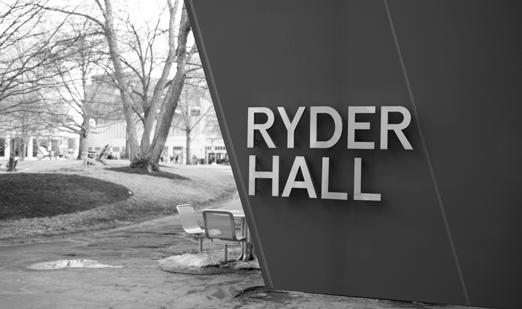
Northeastern unveiled updated plans for a new multi-purpose athletic facility to replace the historic Matthews Arena March 6, providing updated details on the multi-million dollar building’s amenities and capacity.
at Parson’s Field Admission: Free SATURDAY, MARCH 29
Women’s soccer vs. University of Vermont
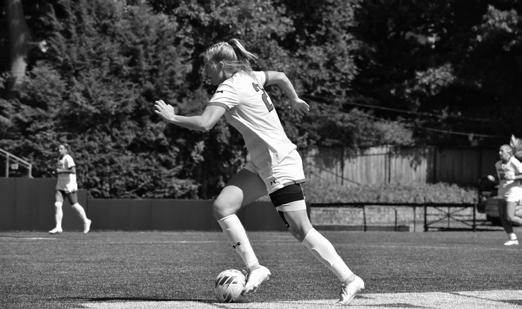
MARCH 30
Northeastern, which acquired Matthews Arena in 1979 but announced it was “reaching the end of its useful life” last spring, is looking to take a different approach with the design of its new facility to accommodate more athletics and events. The plans outline a 310,000-square-foot complex that will occupy the two-acre footprint of Matthews Arena, which includes areas currently used for parking. The project is still awaiting final approvals from the city and state, which will determine deconstruction and construction dates.
The new facility will include an arena that would seat up to 4,050 people for ice hockey games and 5,300 for basketball matches, as compared to its current capacity of 4,666 for hockey and 5,066 for basketball. The men’s and women’s varsity basketball programs will also each have a practice court. There will be redesigned training facilities for athletic teams, office spaces for varsity athletes and coaches and indoor rowing tanks for the men’s and women’s varsity rowing teams. Additionally, there will be a dedicated section behind one of the hockey
During its construction, the men’s basketball program plans to move its games and practices to the Cabot Physical Education Center where the women’s basketball team currently plays, according to the university’s plans. Northeastern is making arrangements with local facilities to host the men’s and women’s hockey practices and games, according to plans shared with The Huntington News.
The university is looking to create a net-zero carbon certification for the facility using reclaimed materials from the destruction of Matthews Arena, as designed by the global architectural firm Perkins&Will.
In recent years, there has been widespread concern about the structural integrity of Matthews Arena given its 115-year lifespan.
The arena stands on man-made land, as Boston’s Back Bay neighborhood and surrounding areas were filled in during the late 19th century. Since its construction, the clay, sand and debris underneath Matthews Arena have shifted, creating an unsturdy foundation due to a combination of low-grade soil makeup and manufactured materials left behind from mid-1800s housing complexes and toxic chemicals including asbestos, The News previously reported.
Several parts of the building have undergone construction, including the offices opposite to the DogHouse.
Northeastern’s 2024 institutional master plan, or IMP, estimated the construction of the new facility at 262 St. Botolph St. would cost between $300 and $350 million.
To finance the deconstruction of Matthews Arena and construction of the new facility, the Massachusetts Development Finance Agency board members voted March 13 to allow Northeastern to sell $650 million of municipal bonds.
According to the IMP, construction on the project is anticipated to begin construction in winter 2025 and be completed by summer 2028. But at a March 12 faculty senate meeting, David Madigan, Northeastern’s provost and senior vice president for academic affairs, said the timeline was still uncertain.
“There is no timeline in terms of when we actually build that. We will build that facility when we can afford it. And so there isn’t a timeline, there isn’t a commitment to put a shovel in
the ground on any given date,” Madigan said at the faculty senate meeting. Northeastern plans to sell $400 million in bonds for the arena while the remaining $100 million will be used for other capital projects on its Boston campus.
Municipal bonds are debt securities issued by states, cities and other governmental entities to fund day-to-day obligations and finance capital projects.
Municipal bonds do not require organizations to pay taxes outside of state and federal taxes on municipal bonds right now; however, the Trump administration is looking to eliminate these benefits. This change would push investors to ask for higher payouts to spend on infrastructure.

hockey knows how to stop
When his goalies trust Dave Flint to look out for them, it shows in their work.
“His character is honestly a big reason why we’ve been so successful. He’s very honest and very helpful. As a goalie, sometimes you’re put in weird positions, and it helps to know your coach has your back,” Gwyneth Philips said.
Jönsson thinks Flint’s secret is successfully identifying goaltenders’ strengths.
“Instead of just reforming us, he’s just working with what he has and trying to make us better at the things we’re already good at,” Lisa Jönsson said.
Flint has recruited exceptional goaltenders into the Huskies’ net for years — some of it is luck and some of it is recognizing skill over size.
Aerin Frankel, who Flint recruited out of Shattuck-Saint Mary School’s hockey team in 2017, wasn’t a top pick going into college, given her 5-foot-5-inches stature. Flint admits that he “hit the lottery.”
“I think my college recruitment process was a little bit different than probably a lot of people that are playing in this league. I wasn’t really highly recruited,” Frankel said.
When she visited Northeastern, Frankel was told she would get a fair shot at the net. It was the first time she believed it.
“People looked past Frankel a lot because of her size, where coach Flint didn’t and was willing to take this unorthodox style goalie and bring her in,” Philips said, who stands at 5-foot7-inches. “I’m not the biggest goalie either, but he was willing to take a chance on me, bringing me in.”
“I think the more talented goalies are going to continue to go to Northeastern because they’re seeing Lisa, Gwyn [and] myself having success,” Frankel said.
No one proves this more than Jönsson herself.
“[My mom and I] started looking into [Northeastern] and then we saw Aerin Frankel and Gwyneth Philips and we were like ‘Oh my god this is such a great school’ so I reached out to coach Flint,” Jönsson said.
When Flint saw Jönsson competing for Sweden at the U18 World Championships — beating Finland and nearly Canada — he knew she was something special.
“I saw the same thing [as Frankel and Philips], you know, a compete level that was really high. And handling pressure really well,” he said.
At 6-foot, “she takes up a lot of net,” Flint said, in contrast to Frankel.
“She doesn’t get too high, she doesn’t get too low and that’s what you need out of a goalie — you just need that consistency night in and night out and then that gives your team confidence too,” Flint said.
Edited by Arielle Rabinovich
“She’s picked up where Gwyn and Aerin left things.”
Jönsson didn’t think she would get to play as a freshman, but after her first game Oct. 12, 2024, she quickly became the Huskies’ starting netminder. And Jönsson might not have known what the Beanpot tournament was before arriving at Northeastern, but after a shutout in the final game, she became the first freshman to take home all of the tournament’s prizes, including the Bertagna Award and MVP — along with the championship trophy.
“I think I’ve only played for a maximum of 3,000 people before. Suddenly you have 10,000 more and it’s just insane,” Jönsson said, referring to the record 13,279 fans in attendance at the 2025 Women’s Beanpot.
Women’s hockey has never gotten the crowds that men’s teams have, but that’s changing. The 2025 Beanpot final brought in the largest women’s hockey crowd in New Eng land history — and everyone knew Jönsson’s name.
“It’s just amazing to hear them scream my name. … I hear them and I’m like ‘Yes!’ and I get so excited and it’s so fun to play when you know you have the support,” Jönsson said.
Just last year, Philips took home a 2-1 victory at the 45th Women’s Beanpot Championship game, the first Women’s Beanpot champion-

ship and consolation games to be played at TD Garden.
“To see what that crowd was versus the same exact scenario four years later … it’s just so exciting to see,” Philips said.
As professional goaltenders in the Professional Women’s Hockey League, or PWHL, Frankel and Philips are at the front of the revolution of women’s hockey and have opportunities women hockey players have never had before.
“I didn’t really have much time to dream about it,” Frankel said. She spent a year playing for the Professional Women’s Hockey Players Association’s team after college when rumors of a new league began circulating. “We were all kind of just
league,” Philips said, referring to the casual, social hockey leagues across the country. She entered college playing behind Frankel for her first three years before starting in her fourth and fifth year; she didn’t see playing professionally as an option before the PWHL.
Flint still tunes in for their games to see the two women dominate in Boston and Ottawa.
When Philips’ Ottawa Charge and Frankel’s Boston Fleet faced off against each other earlier this season, Flint was hoping for a double shutout.
“I texted them after and said, ‘I was hoping for a 0-0 tie, but I’m super proud of you guys,’” Flint said. “To see the two of them as two

ACROSS
1. __ Gras
6. Quick glance
10. Circle segments
14. Popular color on March 17th
15. “Put Your Head On My Shoulder” Singer
16. Spec
17. Seafood chain headquartered in Orlando, Florida
19. Home of “Starry Night”, briefly 20. __ Grigio

21. Sly character in “Dora the Explorer”
23. Animal allowed in the dorms, perhaps 25. Top dogs, abbrev.
28. Contraction for opposers
29. Telescope component
31. “How u been?”
32. Dings
33. First responders, often
36. Gave, in terms of attention
38. “The __ and the Papas”, vocal group from the 1960s
39. Mismatch, like two opposing patterns
43. What you might take after a long day
46. 1977 hit by David Bowie
48. __ Madness
52. Reassuring touch
54. Lamb in a pita
55. Love, in Paris
56. Groom
59. Outlaw
60. Stripes’ opponent, in pool
62. __ Evaluations, platform to rank professors and classes
64. Frames in an animated film
65. Guy who might appear on March 17th
70. Double-reeded instrument
71. Antioxidant-rich berry
72. Pocket square, informally
73. Lies by the pool, perhaps
74. These may be exchanged on one’s wedding day
75. The beginning
DOWN
1. Boss, abbrev.
2. “You __ here” (map pointer)
3. Mammal native to the Eastern Himalayas (2 wds.)
4. Grocery store section
5. “Hole _ __” (2 wds.)
6. Crtl-Vs
7. Sinus specialist, briefly
8. To barely get by 9. Standards, on the green
10. Cherish
11. Like many businesses, after Covid
12. Binder used in construction
13. Begins
18. Spar, perhaps
22. Penguin’s gait
23. “Nightmare on __ street”
24. Appear
26. Northeastern’s programming board
27. Relaxing getaway
30. Integrated circuit card
34. Redeemed, as a check
35. Opposite of NNW
37. German pronoun
40. Chile neighbor, briefly
41. Legumes native to East Asia
42. Goddess of marriage
44. Sidechat, e.g.
45. Blacktop ingredient
47. Sibling to a daughter
48. Paws, vis-a-vis Northeastern
49. Single-celled organism
50. Like some deodorants (2 wds.)
51. Emergencies
53. Colored block arcade classic
57. Before, poetically
58. Tex-mex snack
61. Ukrainian, e.g.
63. Jackie __
66. Environmentally friendly, as a prefix
67. Husky’s foot
68. Lilo’s instrument, shortly
69. Publication from which these clues are based from

Editor-in-Chief
Sonel Cutler
Managing Editors
Ananya Kulkarni Val O’Neill
Editor-at-Large Kate Armanini
Campus Zoe MacDiarmid Lily Cooper
Aiden Stein City Alexis Algazy
Savage Sports Elli Einset Frances Klemm
Lifestyle
Darin Zullo
Christina McCabe
Claudie Bellanger
Opinion
Rachana Madhav Kara Orsini
Projects Alexa Coultoff Emily Spatz
Photo
Elizabeth Scholl
Margot Murphy
Design Catherine Gore Katie Mulcahy
Audiovisual
Jake Guldin
Data
Social Media
Annika Sunkara
Kevin Gallagher
Copy Chief
Web Manager
Arielle Rabinovich
BUSINESS
Business Manager Eli Curwin
Advertising Manager Emily Liu
Outreach Coordinator Anna Morrison
STAFF WRITERS
Aiden Barker, Antaine Anhalt, Aoife Jeffries, Auden Oakes, Ava Vitiello, Bailey Reynolds, Bowen Rivera, Caroline Baker Dimock, Cassandra Joyce, Chloe Craft, Devyn Rudnick, Eleanor Hardy, Eli Curwin, Elsa O’Donnell, Emily Chung, Emily Rodriguez, Grace Cargill, Janira Skrbkova, Jennie Koh, Jenny Tran, Katarina Schmeiszer, Laila Guzman Griffin, Madison Evangelist, Meghan Hirsch, Mikayla Tsai, Nidhi Prakash, Olufolake Okunsanya, Paloma Welch, Samantha Denecour, Sarah Pyrce, Siera Qosaj, Valentina Swan, Yashavi Upasani, Zach Cohen
COPY EDITORS
Aaniya Mahajan, Anne Wang, Antaine
Anhalt, Anya Hill, Aya Al-Zehhawi, Hana Dada, Holly Zbierksi, Jenny Tran, Kristina DaPonte, Sarah Mesdjian, Zach Wilson
DESIGN STAFF
Jessica Xing, Maya Quinlan, Morgan Conway, Natasha Sun
PHOTO STAFF
Asher Ben-Dashan, Aya Al-Zehhawi, Brian Daniels, Chloe Craft, Darin Zullo, David Martínez-Dimnet, Devyn Rudnick, Hana Dada, Molly McAlevey, Nia Calais, Tanvi Saxena
SOCIAL MEDIA STAFF
Daniel Patchen, Emily Chung, Grace Cargill, Kristina DaPonte, Liam Saven BUSINESS STAFF
Annelise Dramm, Isaac Pedersen, Maggie Nahas, Nikolas Lyras, Sencha Kreyerman
Opinions expressed in The Huntington News through letters to the editor, cartoons and columns are not necessarily those of The News staff or the Board of Directors. Northeastern University students conduct all operations involved in the production of this publication. For inquiries about the Board of Directors, email outreach@huntnewsnu.com. For general inquiries, email managing@huntnewsnu.com.
The Huntington News 360 Huntington Ave. 102 Lake Hall Boston, MA 02115 huntnewsnu.com

AVA VITIELLO Columnist
Dear United States of America, why are we so angry at immigrants?
Since his first day in office, President Donald Trump has signed more than 50 executive orders, many concerning immigration, in an attempt to fulfill his promises on immigration and his “America First” mindset, even at the expense of our global standing.
Trump’s immigration policies conflict directly with his economic policies, including his promise to decrease American grocery prices and national inflation. After the flurry of executive orders during the first few weeks of his presidency, we must ask ourselves: Which campaign promise will he truly fulfill?
And more importantly, why are our grocery prices not going down?
The reason for our forgetfulness can be attributed to Trump’s immigration orders, which are causing Americans to have amnesia about his promises about the economy.
One example of these executive orders that induce “amnesia” is “Protecting the Meaning and Value
of American Citizenship,” passed Jan. 20. This order underlines the unprecedented idea that birthright citizenship does not extend to all people born in the jurisdiction of the United States.
Birthright citizenship is outlined in the Fourteenth Amendment of the United States Constitution, stating, “All persons born or naturalized in the United States, and subject to the jurisdiction thereof, are citizens of the United States and of the State wherein they reside.” While this may be phrased using the old-timey jargon of our country’s founders, the core principle of birthright citizenship is clear and cannot be argued.
This is the second time Trump has emphasized his hope to end birthright citizenship. Still, Trump’s attempt at testing the power of the executive branch in this manner is worrisome. Trump is striving to create chaos, fear and confusion so that immigrants who plan on crossing the border illegally are deterred.
More importantly, the chaos resulting from these orders is a strategy to distract the public from the struggle of Trump’s economic policy. While the media is focused on his absurd attempts at rewriting the Constitution, we are not paying
attention to the fact that these measures are hurting Americans’ wallets. If Trump alleged that he would bring down our egg prices on his first day of office, why are we instead seeing an increase in our favorite breakfast items?
When all the undocumented immigrants are deported and no longer paying taxes, American taxes will rise. School taxes will rise when undocumented children are no longer attending public schools. In trying to keep up with all of these executive orders, both the Democrats and Republicans are too distracted to have questions or qualms about the state of our bank accounts.
Economists are warning Americans that expelling undocumented immigrants, who make up about 5% of the American workforce, will harm industries such as construction and agriculture. This is not great for Americans, especially when about 7 in 10 American voters were upset with high grocery prices. Is this not hypocritical? If you are a Trump supporter who is happy with the new immigration policies, think about how you are being affected. Is this the economic outcome you were looking for when you voted?
I beg you to consider the humanitarian consequences of these orders. There is a limitation of humanitarian parole, prevention of asylum seekers at the southern border and a lack of extending temporary protective services. Even if you believe that immigrants are criminals, take a moment to put yourself in their shoes. It is time to recognize that being born in this country is something we all take for granted. Suppose you care about the law when you hear how immigrants are breaking it. In that case, you should care about the 47th President of the United States attempting to override a constitutional amendment.
So, America, will we continue to tune into our national politics and question the government that we elected into power, or will we tune out the noise of politicians and forgo our role as a strong civil society? No matter which political party you belong to, everyone should question an administration that is purposefully initiating chaos.
Sincerely,
Ava Vitiello is a second-year political science major and columnist for The News. She can be reached at vitiello.a@northeastern.edu.
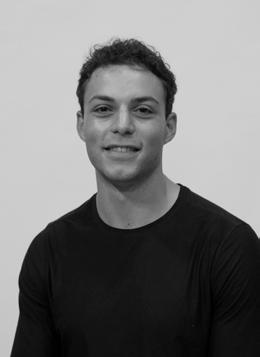
There are serious problems with the educational system in this country.
Plummeting
math scores is one example; being described as “the worst-educated workforce in the industrialized world” is another. The Department of Education has consistently failed in its mission to address this most desperate of crises, and radical reform to the department is crucial.
But what we are witnessing now is not reform; it is demolition. It is not the cutting of a “bloated” government, nor the striving for a “greater efficiency” — and it is certainly not ushering in a new era of government “accountability.”
With the stage set, the script written and the curtains drawn, we are now poised for a re-enactment of the scenes that unfolded just weeks ago in the U.S. Agency for International Development.
Offices will close, contracts will be terminated and 2,200 public servants will be left jobless.
The highest office in the land will quip that “many of them don’t work at all.” Congressional Republicans will applaud, Congressional Democrats will decry and the most powerful special government employee in this nation’s history will call opposition senators “traitors” on X.



@HuntNewsNU
The Trump administration will argue that these cuts empower local school districts, but will nonetheless fail to read the first line in its own website explaining how a miniscule 8% of local school funding comes from the federal government.
We will watch as they warp the English language by rebranding destruction as reform and recasting obfuscation as accountability. They will bombard us with outlandish social media posts and then redirect our focus onto The Next Big Thing. And yet the damage that will be done will remain all the same.
The Federal Student Aid division, by far the largest within the department, will see 25% of its employees terminated. These are the workers who oversee Pell Grants, federal direct loans, federal work-study programs and who process millions of free applications for federal student aid requests, otherwise known as FAFSA. They are the ones who work to improve financial literacy, provide tips on managing student debt and guide us through the complexities of repayment plans.
The Office of Civil Rights, or OCR, established in the aftermath of the 1960’s Civil Rights Movement, will see its employee headcount drop from 557 to around 314. Its 12 regional offices will be gutted — and they will completely shutter Boston’s office.
This is the division which, following a complaint in Los Angeles that Occidental College was not properly combating antisemitism on campus, mediated a settlement between the parties. It was OCR who in 2014 investigated the University of Michigan over its handling of sexual harassment complaints and compelled the university to make substantial changes to its procedures.
In August 2024, over a dozen Northeastern students and alumni filed a complaint against the university, alleging discrimination against Palestinian and pro-Palestinian students. It was OCR who received this complaint.
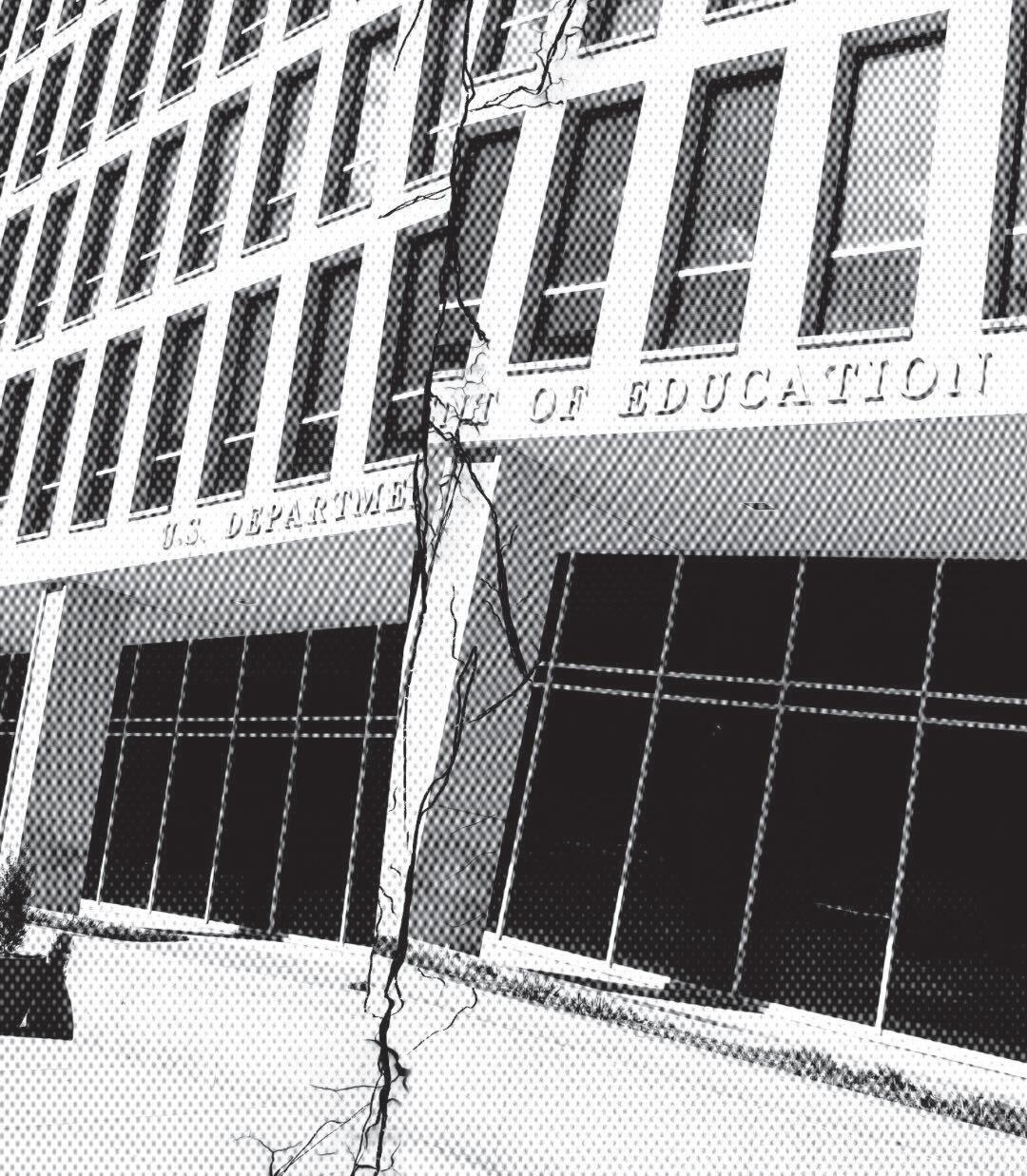
An already severely backlogged complaint pipeline will stretch ever longer. Sexual harassment claims may go uninvestigated. Ramp installations for students in wheelchairs will stall. Anti-discrimination cases levied against universities will go unheeded and bathroom accessibility for transgender students will remain in limbo.
Do not confuse the Trump administration’s distortive verbiage for reality. Adapt the framework that the purpose of a system, and of any action, is what it is actually doing — not what we are being told it does.
As with most everything else we have seen from this administration, the closer we look at the gutting of
the Department of Education, the more we see its outright callousness and sheer incompetence. Look closely. Read deeply. Talk to your friends and family. Speak up during class. Write for The Huntington News. Reach out to people you don’t normally interact with and try keeping them informed. Call your congressmen and show up at town halls. Our faculty is worried and our administrators are petrified — let them know what you think.
Jack Masliah is a fourth-year political science and philosophy major. He can be reached at masliahlitchi.j@ northeastern.edu.


ANTAINE ANHALT Columnist
ANTAINE ANHALT Contributor
“What’s your major?”
This is the ever-so-classic unavoidable question most college students face. Typically, it’s one of the first things you share when introducing yourself. But there’s often a question that comes soon after, one that can be harder to answer — “Why did you pick Northeastern?”
President Donald Trump issued an executive order Jan. 21 attacking diversity, equity and inclusion, or DEI, and related programs across the country, including at “institutions of higher education with endowments over 1 billion dollars” — a category Northeastern falls into with an endowment of $1.85 billion, as of June 30, 2024.
Not long after this executive order, Northeastern began altering — or more specifically, taking down — DEI programs and website pages. What used to be the Office of Diversity, Equity and Inclusion, or ODEI, is now simply the “Office of Belonging.” Moreover, a new “Be-
I started seriously looking for colleges in my freshman year of high school. I zeroed in on Ivy Leagues and high-profile STEM colleges, my sights set on being an engineer. I never could’ve predicted that four years later, the course I’m on now — somewhere along the communication studies path — would be the one I’d eventually choose.
When application season rolled around two years later, I didn’t apply to any Ivy League colleges. I realized that focusing on prestige over happiness wouldn’t do anything positive for me. I needed to find a place that fit me, rather than struggling to fit into an environment that didn’t work out because it looked or sounded “better.”
In the midst of struggling to find colleges that would fit me better,
longing at Northeastern” replaced the ODEI page, And as of Jan. 29, most of colleges and schools at Northeastern have taken down their individual DEI pages, including the Khoury College of Computer Sciences and the D’Amore-McKim School of Business.
I found Northeastern mostly by accident. My dad and I were driving through Boston in early 2023 and passed by the campus, and on a whim decided to check it out. I was tired, having already been on a weekend of college tours, but within 15 minutes of looking around campus, I’ll admit that I was absolutely in love — the (unfortunately now-gone) “book stairs,” beautiful buildings and the amount of outdoor space, and more, were amazing.
investigation isn’t guaranteed. It’s only a risk.
design part of the track anymore, communication studies really was a perfect fit for me.
Instead of taking that risk to stand up for their students, Northeastern decided to roll back its DEI programs within less than a week of the beginning of Trump’s term and showed us what we’re really worth to them: a grand total of not that much.
I decided to apply Early Decision I, and I found out that I was accepted in December 2023.
For a university that prides itself on having a diverse campus, Northeastern can talk about the meaning of diversity all it wants. But actions are another matter — one with far more impact than just words. Without diversity, equity and inclusion, there’s no way to build this culture of “belonging.” How can students and future applicants — particularly minorities — feel as though they belong when their own school doesn’t seem to make them a priority anymore?
The co-op program was a huge draw for me, as it is for most students at Northeastern. Combined majors offered more opportunities for me to explore and find what major I’d like without having to take on a double major.
In regard to location, Boston is a wonderful place to spend your college years. There’s over 30 colleges in the area, so there’s no shortage of people your age to meet and connect with. This is especially important for those struggling to find community at their own school, those with a less common major or niche interest. There’s tons of affordable activities to do and things to see, and you’re not limited to a tiny college town. The city around me has ensured I don’t feel stuck or stranded.
How can we know that Northeastern will still carry on these programs and leave it at only a name change? After affirmative action in college admissions was struck down by the Supreme Court in June 2023, Northeastern had a 35% drop in Black students enrolled for the Class of 2028. If Northeastern is no longer “obligated” to uphold its DEI programs, will it still put effort, time and money into them? Or will these “precious resources” go elsewhere? The answer feels unclear.
But the thing is, college is different for everyone. College life is more of a spectrum, with some preferring social aspects like parties or nightlife, and others preferring academics — a spectrum that’s prone to shift depending on a students’ schedule or workload, but the shifts are different for everyone.
The new Belonging at Northeastern page is so bare that it’s hard to believe that there’s really as big of a commitment to diversity and inclusion programs as Northeastern claims to have.
Before the change, the ODEI website included a concise blurb about its “commitment to global inclusive impact,” far more direct and to-the-point than the new Belonging at Northeastern ones. Also included were clear links to affinity groups, learning development, initiatives and resources, as well as a form to subscribe to their newsletter. All of these have been scrubbed from the Belonging at Northeastern page.
learning to find alternative resources can be difficult.
When President Joseph E. Aoun announced the President’s Council on Diversity and Inclusion in 2013, he said, “If anyone in this community feels that they are not full members of the Northeastern family, that is unacceptable.”
I love Northeastern — I really do. Though, that doesn’t mean it doesn’t fall short in several aspects. These issues include their removal of Diversity, Equity and Inclusion programs, overcrowding and unsafe dining halls for people with allergies.
This change has made many students feel they’re no longer a “full member of the Northeastern family.” That is unacceptable.
Every institution, by nature, will have issues. There’s no such thing as a “perfect” college. But instead of rejecting the institution entirely, it’s better to work together to put pressure on the higher-ups to fix said issues, and continue to apply pressure until the problems are fixed.
My dreams of being an engineer had toned down by then, and I was looking into pursuing art and design. As I went further into the list of majors that Northeastern offered, I came across communication studies. I didn’t know that existed as a major before then, but it looked interesting and I wanted to know more. I talked to my adviser about what I wanted to do in life, and she recommended communication studies combined with design. While I’m not on the
Sure, changing up the websites and DEI programs wasn’t an entirely voluntary option for Northeastern. President Trump’s executive order still has the force of law, and Northeastern would still be possibly subject to federal investigation if it didn’t comply. However, that knowledge does little to lessen how exclusionary these changes feel and what sort of statement this makes to the students of Northeastern. Besides, a federal
Don’t worry

MIKAYLA TSAI Columnist

I’m not sure what I thought college would be like. A lot of media depicts it in a glorified light, with flashy parties and an astonishing amount of alcohol and drugs. On the flip side, if studying is a main focus in a piece of media, it tends to be cliché or hyperfocused on elite institutions like Ivy Leagues. Both of these sides tend to be very exaggerated.
Personally, I’ve found more fulfillment in my small group of friends and focusing on clubs and classes, but that doesn’t mean that’s automatically what’s right for someone else. At Northeastern, there’s plenty of room for students to participate in whichever activities they find best for them, allowing them to explore new interests and figure out new things about themselves. If Northeastern was in a place like a small college town, there wouldn’t be those same opportunities.
The tagline for what used to be the Office of Diversity, Equity and Inclusion was “Northeastern believes in a welcoming and inclusive environment for all.”
Now, those words are nowhere to be found on the Belonging at Northeastern page.
I wasn’t sure which side Northeastern would fall on — it’s a very academically rigorous school, but there’s a lot of access to nightlife and other “party” activities. I’ve never been much of a partygoer, and I find myself sticking to the academic side of the scale.
So do those values still hold true? Does Northeastern really still believe in a “welcoming and inclusive environment for all,” or was it all performative? Northeastern uses diversity as a pull to encourage students to apply — but without a committed DEI program, how trustworthy is that rhetoric?
Although, a lot of media focusing on young adults in college fail to show the struggles and challenges that many students face in a realistic manner.
Moving away from home and learning to live independently isn’t easy. While I’ve found so much joy in my friends and the connections I’ve made at Northeastern, there’s still a lot of stress. Northeastern’s resources aren’t always able to provide the level of support that I need, and
Now, as of Feb. 14, the Belonging at Northeastern page features two surface-level paragraphs about “fostering a community of belonging,” a handful of photos showcasing “diversity” that truthfully feel tokenizing and a menu with a mere two options: the “Presidential Council on Belonging” and “Affinity Groups.” Northeastern once told students that there was value in their diverse identities and viewpoints. Now, they’re stripping that messaging down. “Belonging” isn’t the same as “diversity and inclusion.” “Belonging” is when someone gets to decide who has the right to be in any space, whereas “inclusion” means all are welcome. For students who are part of these underrepresented communities, these alterations feel like a stab in the gut.
I firmly believe that, with enough work, we as students can help remedy these issues. Change doesn’t happen overnight, and giving up does no good.
Unintentional or not, with the removal and altering of these DEI pages, Northeastern has just made several thousands of students feel like they’re not as important as those who don’t benefit from DEI programs. Students of color, LGBTQ+ students, disabled students and Jewish students currently still have affinity groups from Belonging at Northeastern, but how long will that last? How long until Northeastern decides they are tired of putting in these resources? Will they last through the next four years?
There’s no way to know.
College has brought many surprises, both positive and negative. But no matter where I ended up, I would still be facing a lot of these challenges. I’m not sure of what the future holds.
But I know one thing for sure — if I could go back and do it all over again, I’d still pick Northeastern.
Harvard University still has its DEI page up. So do Boston University, the Massachusetts Institute of Technology and Brandeis University. And these colleges also all have endowments north of $1 billion.
So, Northeastern, what’s your excuse?
Antaine Anhalt is a first-year communication studies major and columnist for The News. He can be reached at anhalt.a@northeastern.edu.
Antaine Anhalt is a first-year communications studies major. He can be reached at anhalt.a@northeastern.edu.
Trump’s research funding freeze isn’t something we can just ignore, this affects you too
For those who aren’t yet fazed, let’s talk about the specific parties impacted.
Amid the reign of executive orders and depressing news coming from the White House, overhearing the words “federal funding freeze” and “meet immediately” uttered within the Northeastern lab where I work was enough to confirm that the research realm as we knew it would never be the same again. No matter what profession within the field of science you are planning on pursuing — be it a doctor, researcher or professor — all professional livelihoods are at risk.
The last time I was at the nail salon, I sat in the chair across from one of my favorite nail technicians, talking about winter break and our families. When the topic of college inevitably came up, our conversation turned to graduation, which is quickly approaching for me this upcoming May. I began to tell her about my final semester and my plans for after graduation.
I hadn’t realized how nervous the thought of graduating made me until my nail technician told me to relax my hands. In explaining the next six months of my life and my hopes for
The announcement came without warning. On Jan. 29, President Donald Trump’s White House budget office froze all federal funds and loans to review government spending to ensure it aligned with executive orders. On the surface, this decision looked like an effort on Trump’s part to take on more accountability in ensuring that money is spent wisely, but don’t be fooled by his righteous facade.
Immediately after this executive order was released, chaos began trickling down from the big guns. It resulted in a catastrophic move estimated to slash $400 billion in funding from the National Institutes of Health, the largest financial supporter of biomedical and behavioral research in the world.
the next few years, I had gotten so tense that she couldn’t file my nails. After taking a deep breath and letting my hands go limp, I said something which very likely resonates with a lot of graduating students.
“It’s scary to think about graduating when all I’ve ever known is school.”
For as long as I can remember, I’ve always known exactly what lay ahead of me: elementary school then middle school, to high school then college. Now, college then what? Of course, I have generic ideas about getting a job and preparing to go to graduate school, but these plans have a lot less solidity and direction than I’ve had in the past.
Direct funding supports the bread and butter of a research project, including scientists, supplies, salaries and equipment. While Trump’s proposed policy doesn’t target direct funding that serves to support the core elements of a research project, this order targets the “indirect costs,” also known as facilities and administrative costs. Losing facilities and administrative funding endangers a wide array of invaluable resources utilized in the research space, whether it be infrastructure, administrative support, federal compliance for animal care or access to electronic databases and journals.
Five years ago when I visited Northeastern’s campus for the first time, enamored by the city and academic environment I was surrounded by, I told my mom I was going to college here with a confidence I don’t think I’ve had since. Four months away from graduation, I feel nothing but uncertainty about what the future holds.
To this sentiment, my nail technician replied with the ever-so-overused statement of, “Don’t worry, you still have so much time.”
If you still believe that this policy exclusively impacts those currently working in the scientific community, think bigger. While large-scale research institutions and a fraction of academia have already felt the initial chill, there will be ensuing damage on the future generation of researchers. In an era that relies so heavily on scientific advancements, the last thing we need are individuals with immense potential second-guessing their future career paths due to fear of the unknown and massive cuts in their departments.
Within the realm of academia, undergraduates across the nation are being negatively impacted by this policy, even if they aren’t at the forefront of submitting grant
With so little certainty about the future, it’s easy to feel like life comes to a screeching halt after graduation. Most of the things
proposals. If the shutdown continues through the federal fiscal year, ending Sept. 30, the consequences could be even greater as Northeastern research relies on federal agencies for a significant portion of funding — in 2019, around 80% of Northeastern’s research funding was sourced from federal government agencies. With an increase in research faculty layoffs, we’re not just losing world-class scientists, but also missing out on potential lifelong mentors who play a key role in shaping a student’s career pathway.
that have given our college lives structure and meaning won’t remain the same once the college part comes to an end. Schedules and responsibilities shift, friends move away and we feel an overwhelming urge to figure out exactly what we’re going to do about it now so that we don’t feel the anxiety of anticipating those changes.
But no matter how hard I’ve tried to come up with a magical way to prepare for how different my life will be after graduation, the reality is that there isn’t one. We have to accept that change is coming, and likely in ways we can’t predict.
During a stressful period working in the intensive care unit for my previous co-op at Brigham and Women’s Hospital, I relished the chats I’d have with my supervisor, who’d always ask how I was doing outside of the research space. Her advice was what ultimately led me to tailor my co-op experience to better fit my needs, which left me all the happier and affirmed my decision to pursue a career in medicine. I would have been very close to dropping the premed path if not for the one-on-one guidance and thorough instruction she gave me.
I’ll be the first to admit that “going with the flow” is something I’ve never quite been good at. My closest friends will tell you that I am probably the most Type A person they’ve ever met (I’ll never forget the looks of concern I got the time they found me unloading and reloading the dishwasher because the way the dishes were arranged was stressing me out — it was perfectly fine). But in light of my changing status from college student to graduate, I’m also trying to change my status as a self-proclaimed control freak.
There is a lot that I can’t change about what will happen after graduation, and there’s a lot I can’t plan for. But I can control my attitude about life post-grad. Approaching the coming years with apprehension won’t serve me in making the best of my 20s (or 30s or 40s), nor will it
In short, the federal funding freeze significantly impacts undergraduate students in the field of science, not just by reducing research opportunities due to fewer labs nationwide, but also by leading to lower acceptance rates into graduate programs — potentially decreasing job prospects. With our livelihoods at stake, we have every reason to panic.
make any of the things I worry about suddenly resolve.
And as much as I love my life as it is right now, I have to remember that what I love about it isn’t the intricacies of being a college student like registering for classes or studying for next week’s quiz. I love what I’ve made of my time in college — writing and learning feverishly, sitting with my friends in my sunny living room for hours on a Sunday and walking around Boston Common looking for acorns to give to the squirrels.
If you are a non-science major, you may be under the impression that the federal freeze has nothing to do with you. You would be wrong. As we advance into adulthood, we are increasingly susceptible to widespread diseases such as cancer, respiratory diseases and neurodegenerative disorders. How would it feel to reach that vulnerable point in our lives, only to find that the treatment we desperately need doesn’t exist simply because progress has been stalled? What we have been working toward and researching has now lost all its steam. With new treatment options taking around 12 years to reach the market, losing a few years could mean the difference between hope and heartbreak for countless lives.
All of these memories are a result of who I am, not my status of “college student,” and I have all the opportunity in the world to continue making more of them after I take off my cap and gown.
Large-scale industries such as the National Institutes of Health, or NIH, which are directly impacted by the federal freeze, play a crucial role in biomedical research and have provided $32 billion in funding for 60,000 grants in basic, translational and clinical studies.
It’s important that we recognize our diplomas are not metaphorical death certificates for the people we were as college students,
Among other reckless decisions, Trump proceeded to fire workers at the NIH’s Center for Alzheimer’s and Related Dementias, including lead researcher Kendall Van Keuren-Jensen, who was expected to bring significant advancements within this niche field. This could jeopardize the quest for new Alzheimer’s treatments — something we cannot afford right now.
Nearly 7 million people in the U.S. are living with Alzheimer’s disease, and there is currently no cure.
meant to impose a feeling of impending doom about the future.
No matter how cliché it sounds, graduation really is the start of the rest of our lives, even if we’re not sure what it’s going to look like yet. So, while the anxiety you feel may be incredibly uncomfortable, you can and must confront it with an appreciation for all of the good that has yet to come.
Kara Orsini is a fourth-year Health Science major. She can be reached at k.orsini@huntnewsnu.com
Trump enforces this policy in an attempt to “end the egregious waste of federal funding” and ensure that money is being used wisely. Even so, this statement fails to acknowledge that money spent on research endeavors is paid back in abundance — driving groundbreaking advancements in knowledge and directly improving the lives of individuals on a global scale. Instead of cutting research funding, why doesn’t the president focus on reducing federal government waste in other, far less critical areas — say, the Department of the Interior spending $12 million on a 30-court pickleball complex or the $365,000 spent by the National Endowment for the Arts to promote circuses?
What sets Northeastern apart from other institutions is the robust co-op program. However, with research progress at a standstill, we may soon lose that too. As of 2019, 90% of Northeastern graduates who complete a co-op secure full-time employment within nine months of graduation. This experience gives undergraduates the opportunity to get their foot in the research door, which is something that isn’t simply handed to you on a silver platter. With so much at stake, we cannot afford to waste time on a policy that serves as nothing more than a political stunt or power play.
Mikayla Tsai is a third-year behavioral neuroscience major and columnist for The News. She can be reached at tsai.mik@northeastern.edu
